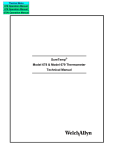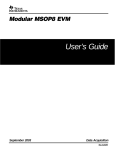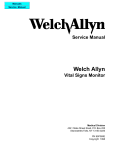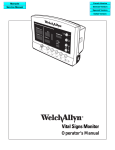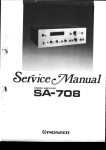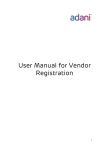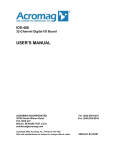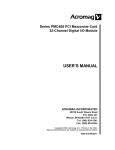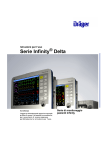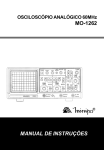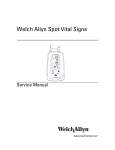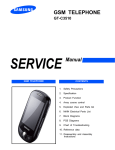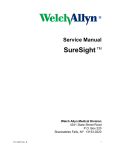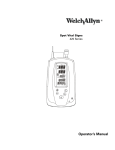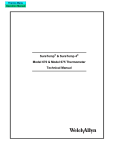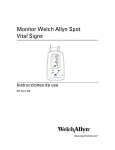Download Service Manual Spot Vital Signs
Transcript
Manuals Operator Manual Service Manual Spot Vital Signs PN 95P506E Copyright 2001 Welch Allyn, Inc. Spot Vital Signs Service Manual Revision A Spot Vital Signs Service Manual Page 2 of 64 Welch Allyn, Inc. Spot Vital Signs Service Manual Revision A Revision History Version A Date 3/31/01 Author JDB Description Introduction of Service Manual Page 3 of 64 Welch Allyn, Inc. Spot Vital Signs Service Manual Revision A Table of Contents Section 1 General Information ................................................................................................................5 1.1-To Service Personnel:......................................................................................................................5 1.2 Limited Warranty............................................................................................................................6 Service Policy....................................................................................................................................6 Technical Assistance .........................................................................................................................6 1.3 Basic System Description ................................................................................................................8 Introduction.......................................................................................................................................8 1.4 Basic System Operation ...................................................................................................................9 1.5 Specifications ................................................................................................................................13 1.6 Identification Label and Serial Numbering System Defined ...........................................................16 1.7 Firmware Identification .................................................................................................................17 Section 2 Service ....................................................................................................................................18 2.1 Intent of Manual and Product Scope. .............................................................................................18 2.2 Test Equipment Bench Layout:......................................................................................................19 2.3 Required Tools and Fixtures for Service .......................................................................................20 2.4 Required Tools and Fixtures for Service .......................................................................................21 2.5-Replacement Parts :.......................................................................................................................22 2.6-Supplies and Accessories:..............................................................................................................22 2.7 Maintenance and Service Support.....................................................................................................25 Section 3 Problem Diagnosis...................................................................................................................26 3.1 Diagnostic Procedure for Returned Units..........................................................................................26 3.2 Calibration Procedure : Voltage ......................................................................................................29 3.3 Calibration Procedure : Pressure..................................................................................................30 3.4 SELF DIAGNOSTIC FAULT CODES ..........................................................................................31 3.5 COMPLAINT / CAUSE / CORRECTIVE ACTION.....................................................................33 Section 4 Removal/Replacement of Parts.................................................................................................39 4.1 Battery...........................................................................................................................................39 4.2 Temperature Pod and Temperature Connector PCB removal .........................................................40 4.3 Front Housing and Switch Array ...................................................................................................41 4.4 Display PCB.................................................................................................................................42 4.5 Remove Power and Battery Cable ..................................................................................................43 4.6 Main PCB Removal.......................................................................................................................44 4.7 SpO2 PCB Removal (If configured with SpO2) ............................................................................45 4.8 Pump and Valve Removal..............................................................................................................46 Section 5 Test Procedures........................................................................................................................47 Section 5.1 Calibration Tests...............................................................................................................47 Section 5.2 Current Tests ....................................................................................................................48 Section 5.3 Noise Levels......................................................................................................................49 Section 5.4 Button Test .......................................................................................................................50 Section 5.5 Interface Test ....................................................................................................................51 Section 5.6 Print Quality .....................................................................................................................52 Section 5.7 Pneumatic Tests ................................................................................................................53 Section 5.8 SpO2 Tests........................................................................................................................54 Section 5.9 Temperature Tests.............................................................................................................55 Section 5.10 Fail Safe Testing .............................................................................................................56 Section 5.11 Check List For Spot Vital Signs Service Work ..............................................................57 Section 6 Drawings .................................................................................................................................59 Section 7 Repair Test Specifications........................................................................................................60 Page 4 of 64 Welch Allyn, Inc. Spot Vital Signs Service Manual Revision A Section 1 General Information 1.1-To Service Personnel: Read and understand the Spot Vital Signs Operator’s Manual and this Service Manual. The information contained in both of these publications is subject to change without notice and should not be construed as a commitment by Welch Allyn, Inc. Welch Allyn assumes no responsibility for any errors that may appear in this manual. If the product and/or its operation varies significantly from any description herein, please contact the following: WELCH ALLYN,, INC. TECHNICAL SERVICE DEPARTMENT: 1-800-450-9275 (828) 684-4895 Fax (828)687-1002 Welch Allyn,, Inc. . 95 Old Shoals Road Arden, North Carolina 28704 This product has been designed to provide a high degree of safety and reliability. However, we can not guarantee against: deterioration of components due to aging, normal wear, tampering, and abuse. All service and repairs must be performed by authorized Welch Allyn personnel or agents, using approved Welch Allyn replacement parts and approved process materials. Failure to so will invalidate the product warranty. Please refer to the product warranty for specific coverage. Welch Allyn, Inc. 95 Old Shoals Road Arden, North Carolina 28704 USA 1 800 450-9275 Page 5 of 64 Welch Allyn, Inc. Spot Vital Signs Service Manual Revision A 1.2 Limited Warranty Welch Allyn, Inc. warrants the Spot Vital Signs, when new, to be free of defects in material and workmanship and to perform in accordance with manufacturer's specifications for a period of two years from the date of purchase from Welch Allyn, Inc. or its authorized distributors or agents. Welch Allyn, Inc. will either repair or replace any components found to be defective or at variance from manufacturer's specifications within this time at no cost to the customer. It shall be the purchaser's responsibility to return the instrument to Welch Allyn, Inc. or an authorized distributor, agent or service representative. This warranty does not include breakage or failure due to tampering, misuse, neglect, accidents, modification or shipping. This warranty is also void if the instrument is not used in accordance with manufacturer's recommendations or if repaired by other than Welch Allyn, Inc. or an authorized agent. Purchase date determines warranty requirements. No other express warranty is given. To receive service assistance or to ask questions regarding this warranty, please call or write: Welch Allyn, Inc. Technical Services Dept. 95 Old Shoals Road Arden, North Carolina 28704 USA 1 (800) 450-9275 or (828) 684-4895 Fax: (828) 687-1002 Service Policy All repairs on products under warranty must be performed or approved by a Welch Allyn, Inc. Service Center. Unauthorized repairs will void the warranty. Products out of warranty should be repaired by qualified electronics personnel or a Welch Allyn, Inc. Service Center. Technical Assistance If you have an equipment problem that you cannot resolve, call the Welch Allyn, Inc. Service Center nearest you for assistance. Technical service support is available to you by telephone on normal business days at the locations listed on the next page Page 6 of 64 Welch Allyn, Inc. Spot Vital Signs Service Manual Revision A Before returning a product for repair you must obtain authorization from Welch Allyn, Inc. An RMA (Return Material Authorization) number will be given to you by our service personnel. Be sure to note this number on the outside of your shipping box. Returns without an RMA number will not be accepted for delivery. Welch Allyn, Inc. Service Centers For Service or Repair USA Customers Welch Allyn, Inc. Technical Service Centers 95 Old Shoals Road Arden, NC 28704-9739 USA Phone: 828-684-4895 Fax: 828-687-1002 CANADA Customers Welch Allyn Canada Limited Technical Service Centers 160 Matheson Blvd., East Mississauga, Ontario L4Z CANADA Phone: 905-890-0004 or 1 800-561-8797 Fax: 905-890-0008 INTERNATIONAL Customers Welch Allyn GmbH Technical Service Center Zollerstrasse 2-4 Road D-72417 Jungingen GERMANY Phone: [49]-7477-927-10 Fax: [49]-7477-9271-90 Welch Allyn Australia Pty. Ltd. Technical Service Center 5/38-46 South Street Rydalmere NSW 1701 AUSTRALIA Phone: [61] 29-4183-155 Fax: [61] 29-4183 650 Welch Allyn Ltd. 21-09 Golden Mile to 6001 Beach Road Singapore 199589 REPUBLIC OF SINGAPORE Phone: [65]-291-0882 Fax: [65]-291-5780 Welch Allyn UK Ltd. Cublington Road Aston Abbots Buckinghamshire HP22 4ND UNITED KINGDOM Phone: [44] 129-668-2140 Fax: [44] 129-668-2104 LATIN AMERICA Customers MDI International Technical Service Centers 7324 SW 48th Street Suite A Miami, FL 33155 USA Phone: (305)-669-9591 Fax: (305)-669-1971 Page 7 of 64 Welch Allyn, Inc. Spot Vital Signs Service Manual Revision A 1.3 Basic System Description Introduction The Welch Allyn Spot Vital Signs is designed to non-invasively and automatically measure systolic and diastolic pressure, pulse rate, temperature and oxygen saturation (SpO2 ) for adult and pediatric patients. THE WELCH ALLYN SPOT VITAL SIGNS IS NOT INTENDED TO BE USED ON NEONATAL PATIENTS. All blood pressure, pulse, temperature and SpO2 values can be viewed on a large, easy-to-read display, and may be printed via the IrDA port to an external printer as desired. The rechargeable lead acid battery and variety of mounting accessories make the Welch Allyn Spot Vital Signs convenient for many locations. The operator may choose any combination of simultaneous measurement modalities. The Welch Allyn Spot Vital Signs is intended for use in a wide variety of health care settings. This includes hospital departments, as well as alternate care settings, such as physicians offices, clinics, and long term care facilities. The Welch Allyn Spot Vital Signs is not intended for continuous monitoring of patients, or for use during transport of a patient. The Welch Allyn Spot Vital Signs is not intended for use in environments that are not supervised by a health care practitioner. Refer to the Spot Vital Signs Operator’s Manual for complete information on Indications For Use, Special Features, Supplies and Accessories Page 8 of 64 Welch Allyn, Inc. Spot Vital Signs Service Manual Revision A 1.4 Basic System Operation Blood Pressure Measurements A single blood pressure determination is made when the blood pressure START/STOP button is pushed. A measurement cycle may be cancelled at any time by pressing the BP START/STOP button again. This action immediately initiates a rapid cuff deflation. The blood pressure measurement data will appear on the display immediately following the measurement and remain displayed for two minutes. After two minutes, the display goes blank, and the device will go into standby mode. The most recent BP measurement may be recalled by pressing the Print, Mode, Next Patient/Clear or BP Start/Stop button. Max/Min Blood Pressure Ranges The maximum and minimum ranges of blood pressure are detailed below: Mean Arterial Pressure (MAP) Ranges 40 - 190mmHg Calculated from Systolic and Diastolic data (not directly measured). Temperature Operating Modes Thermometry measurements are made with the Welch Allyn SureTemp ™ technology. Oral and rectal probes utilize single-use disposable probe covers that limit cross-contamination. Oral, axillary or rectal temperatures are taken using ‘Normal or ‘Monitor operating modes. Axillary temperatures are taken using the (blue) oral probe. Page 9 of 64 Welch Allyn, Inc. Spot Vital Signs Service Manual Revision A Rectal temperatures are taken using the (red) rectal probe. In the Normal mode the thermometer's microprocessor "predicts" body temperature in about 4 seconds for oral temperatures, about 10 seconds for axillary temperatures, and in about 15 seconds for rectal temperatures. The monitor mode displays the patient’s actual temperature after 3 minutes for oral/ rectal mode and 5 minutes for axillary mode, and will continue to display an updated temperature as long as the probe remains in place. Temperature readings may be displayed in Fahrenheit or Celsius scales. Max/Min Temperature Ranges Temperature Normal Mode In Normal Mode, the Spot Vital Signs will measure temperature at discrete intervals and then calculate the rate of change according to a proven algorithm. This allows the thermometer to predict the end point that the thermistor would reach if it were left in the mouth until it reached mouth temperature. This predictive feature allows the thermometer to arrive at an accurate oral temperature reading in approximately 4 seconds. Normal mode is the default operating mode for the temperature determinations. Operator selectable patient alarm limits are not available in temperature Normal mode. However, temperatures that are outside of the operating range of the device will be noted on the temperature display. Temperature Monitor Mode Continuous Monitor Mode operation is normally used when difficult situations prevent accurate temperatures from being taken in the Normal mode. The probe must be in contact with tissue for at least three minutes for accurate oral/rectal temperature measurement and five minutes for accurate axillary temperature measurement. Monitor mode temperatures may not be identical to predicted ‘Normal’ temperatures because of ambient temperature influence and other factors The trend in temperature is the important standard to be observed when in the Monitor mode. Operator selectable patient alarm limits are not available in temperature monitor mode. However, temperatures that are outside of the normal operating range of the device will be noted on the temperature display. SpO2 Operating Mode * The Spot Vital Signs incorporates the Nellcor Puritan Bennett ™ pulse oximetry system which determines arterial oxyhemoglobin saturation (SpO2 %) by measuring the absorption of red and infrared light passed through the tissues. Page 10 of 64 Welch Allyn, Inc. Spot Vital Signs Service Manual Revision A * Changes in absorption caused by pulsation of blood in the vascular bed are used to determine arterial saturation and pulse rate. Oxygen saturation percent is calculated with each pulse detected, and thus the device display is continually updated. The pulse signal bar graph is an indicator of the strength and quality of the detected pulses. * The Spot Vital Signs is capable of determining pulse rate as an adjunct to the blood pressure measurement and the SpO2 measurement. * The pulse rate, in beats per minute, will be determined primarily from the SpO2 measurement methodology. In the case where SpO2 is not available, or is disabled, the pulse rate display will be driven from data collected as part of the blood pressure measurement method. * Removal of the SpO2 sensor from the patient will initiate an audible beep, to alert the user that the sensor has been disconnected. * SpO2 is generally measured via pulses detected using a finger sensor, and performs most accurately with the finger clip sensor. The finger clip sensor may be used on all fingers except the thumb. For certain situations SpO2 may be measured at alternate sites including the earlobe, forehead and toes. Special sensors must be employed in these situations. The finger clip sensor is recommended for spot checks or short-term evaluation (less than 60 minutes). Patient supervision is required as the Spot Vital Signs has no alarm capability. * Oxygen Saturation and pulse rate is displayed on the LCD display. On each detected pulse, the pulse signal bar graph flashes. The intensity of this signal is a simple visual indicator of waveform signal strength, and can identify situations where the pulsatile nature of the tissue may not be adequate for an accurate SpO2 reading. The update interval bar of the bar graph should correspond to the patient’s pulse rate. This is an indication of the quality of the SpO2 signal. Max/min SpO2 Ranges The SpO2 sensor is designed to detect oxygen saturation as follows: Page 11 of 64 Welch Allyn, Inc. Spot Vital Signs Service Manual Revision A Pulse Rate Feature The Welch Allyn Spot Vital Signs is capable of determining pulse rate as an adjunct to the blood pressure measurement and the SpO2 measurement. The pulse rate, in beats per minute, will be determined primarily from the SpO2 measurement methodology. In the case where SpO2 is not available, or is disabled, the pulse rate display will be derived by data from the blood pressure measurement method. Max/Min Pulse Rate Ranges The maximum and minimum pulse rate ranges are as follows: Page 12 of 64 Welch Allyn, Inc. Spot Vital Signs Service Manual Revision A 1.5 Specifications The performance specifications of the Spot Vital Signs are as follows: Patient Population The Welch Allyn Spot Vital Signs is designed for use with adult and pediatric patients. Welch Allyn defines a pediatric patient as 29 days old and above. THE SPOT VITAL SIGNS IS NOT INTENDED FOR USE WITH NEONATES. Welch Allyn defines neonates as children 28 days or less of age born at term (37 weeks gestation or more): otherwise, up to 44 gestational weeks. Cuff Pressure Range 0 mmHg - 300mmHg Initial Cuff Inflation 160 mmHg, smart inflation Systolic Determination Maximum: 250 mmHg Minimum: 60 mmHg Diastolic Determination Maximum: 160 mmHg Minimum: 30 mmHg Blood Pressure Accuracy Blood pressure accuracy meets or exceeds SP10-1992 AAMI standards for non-invasive blood pressure accuracy (AAMI standard: ± 5 mmHg mean error; 8 mmHg standard deviation). Blood pressure accuracy is validated for pressure measurement using the upper arm only. Blood Pressure Determination Time 20 seconds to 45 seconds typical, 165 seconds maximum. Pulse Rate Determination (Using SpO2 determination) Maximum: 245bpm Minimum: 25bpm Pulse Rate Accuracy SpO2 Module Heart Rate ±3.0 bpm Blood Pressure Algorithm Heart Rate ±5.0 Page 13 of 64 Welch Allyn, Inc. Spot Vital Signs Service Manual Revision A Overpressure Cutoff 315 mmHg ±15 mmHg Temperature Ranges Temperature Accuracy Temperature accuracy meets or exceeds ASTM E112-86: "Standard Specification for Electronic Thermometer for Intermittent Determination of Patient Temperature." Temperature Determination Time (Oral) 4 seconds typical, 15 seconds maximum (Axillary) 10 seconds typical (Rectal) 15 seconds typical Oxygen Saturation Range (SpO2 %) 40-100% oxygen saturation SpO2 Accuracy ±3% in the range of 70-100% oxygen saturation (1 Standard Deviation) <70% unspecified by the OEM. Battery Charging To 90%-100% capacity in 12 hours. Unit will operate and charge battery simultaneously when connected to power source. Mechanical Specifications Dimensions Height 9.70 inches (24.64 cm) Length 5.72 inches (14.53 cm) Depth 4.73 inches (12.01 cm) Page 14 of 64 Welch Allyn, Inc. Spot Vital Signs Service Manual Revision A Weight Approximately 4.25 pounds Mounting Self-supporting on rubber feet Custom Mobile Stand Custom Made Wall Mount Portability May be hand carried when held by the rear handle. Electrical Specifications Power Requirements Patient-Rated isolation transformer is connected to AC mains: North American Version: 120VAC, 60 Hz. 0.20A Input Source, 8VDC, 0.75A Output Source International Version: 220-240VAC, 50-60Hz 0.20A Input Source, 8VDC, 0.75A Output Source Battery Lead acid, with external charger. A fully charged battery will support 150"typical" blood pressure determinations taken at 7 minute intervals. Battery is 90-100% charged after 6-12 hours of charging. The battery automatically charges when the Spot Vital Signs is powered through the AC power transformer. The battery will charge faster when the instrument is not in operation. Environmental Specifications Operating Temperature +10°C to +40°C (Except temperature 16°C to 40° C) +50°F to +104°F Storage Temperature -20°C to +50°C -4°F to +122°F Relative Humidity 15 to 90% (non-condensing) Operating Altitude -170m to +4877m -557ft. to +16,000ft. Page 15 of 64 Welch Allyn, Inc. Spot Vital Signs Service Manual Revision A 1.6 Identification Label and Serial Numbering System Defined The identification label for the 420 Series Spot Vital Signs is shown below. It is located on the bottom of the unit. The serial number for the device would consist of nine (9) numbers and a bar code. These would be located in the square below the words “420 Series.” An example of the number and the explanation is shown below: 200100001 The four digits on the left Are the year of manufacture of the device. The five digits on the right are the sequence of build starting with 00001 annually. (The example number above would be the first unit built in 2001) Page 16 of 64 Welch Allyn, Inc. Spot Vital Signs Service Manual Revision A 1.7 Firmware Identification To confirm the software levels of the 420 Series Spot Vital Signs, place the unit into the “Configuration Test” mode by holding down the Start button while the unit is being powered up. The main software versions will appear as follows: * In the SW1 Screen, the top two numbers is the software version of the Spot Module and the other numbers are for the SpO2 module (if installed). Press the “Start” or “Clear” button to cycle through the SpO2 software number. In the SW2 screen, The two numbers represent the NIBP module software and the Temperature Algorithm Version (If temperature is active.). Note: Verify the firmware levels by reviewing the Repair Test Specifications document. Page 17 of 64 Welch Allyn, Inc. Spot Vital Signs Service Manual Revision A Section 2 Service 2.1 Intent of Manual and Product Scope. This manual provides technical service and re-calibration information to technicians authorized to repair and recalibrate Welch Allyn, Inc. products. When used in conjunction with the required test equipment and tools, technicians will be able to diagnose, repair, and recalibrate, and test the Spot Vital Signs. The manual includes: Re-calibration instructions, fault/cause analysis, step by step disassembly and reassembly procedures, repair, adjustment, and re-test procedures. Page 18 of 64 Welch Allyn, Inc. Spot Vital Signs Service Manual Revision A 2.2 Test Equipment Bench Layout: Figure 2.2 depicts recommended layout of test equipment and special tools for service and recalibration of the Spot Vital Signs. 500 CC Volume 250 CC Volume 100 CC Volume DMM Voltage + Power Supply - + DMM Current - + Setra Meter Or Netech Meter To black wire To red wire Connect To Power of the Spot Check Device 2” Tubing 3” Tubing 4” Tubing 15” Tubing Welch Allyn Spot Device 10” Tubing To the Spot Vital Signs Nellcor Patient Simulator SRC-2 3” Tubing To Bulb and Valve Diatek Calibrator 9600 PC, IBM Comp. 486 133 MHz, 8 Mb RAM Windows 95 OS FIGURE 2.2 BENCH LAYOUT FOR RE-CALIBRATING AND TESTING SPOT VITAL SIGNS Page 19 of 64 - Welch Allyn, Inc. Spot Vital Signs Service Manual Revision A 2.3 Required Tools and Fixtures for Service Special tools below can be ordered from Welch Allyn, Inc. DESCRIPTION TOOL # 100cc TEST VOLUME T112819 250cc TEST VOLUME T112818 500cc TEST VOLUME T112854 DIGITAL TIMER 8456T12 PLIERS T112458 BULB AND VALVE 5088-01 WIRE CUTTERS T112486 TWEEZERS T112511 PNEUMATIC TUBING (3 ea.) 5089-12 "Y" FITTING 9586TPK4 "T" FITTING (3) 9585TPK4 TEST CABLE (IR) 66P824 TEST CABLE (Service Cable Kit) 66S553 PNEUMATIC CLAMPS (3) 21730-001 TORQUE SCREWDRIVER T112917 TORQUE SCREWDRIVER T112918 TORQUE DRIVER T112918A CUSTOM REPAIR SOFTWARE 130S57 #4 PHILLIPS BIT T112919 T10 TORX BIT T114030 3/8 HEX SOCKET T114135 CABLE TIE TOOL T112845 DIATEK 9600 CALIBRATOR 01800-210 DIATEK CAL. KEY 06137-000 NELLCOR PATIENT SIMULATOR SRC-2 NELLCOR TEST CABLE EC-8 SERVICE MANUAL 4200-145E DIGITAL PRESSURE METERS SETRA METER (0-10 PSIG) 2270-01 NETECH METER 200-2000IN Notes: The entire set of equipment listed above can be ordered through Welch Allyn by the following number: Eleckit A Setra Meter (2270-01) or a Netech Meter (200-2000 IN) must to be ordered along with the Eleckit. Individual equipment numbers can be ordered by themselves. NO DISCOUNTS Page 20 of 64 Welch Allyn, Inc. Spot Vital Signs Service Manual Revision A 2.4 Required Tools and Fixtures for Service The following equipment is need for service/repair and can not be obtained from Welch Allyn, Inc. - IBM compatible 486 133 MHz computer or better. The computer must have Windows 95 with a serial port. CPU must have 8 Megabytes of RAM. - 2 Digital Multi-Meters. These meters must have 4 1/2 digit displays for accuracy. - Power Supply. 0-20 Vdc adjustable with 0-3A output. - Oscilloscope. 60 MHz minimum. Page 21 of 64 Welch Allyn, Inc. Spot Vital Signs Service Manual Revision A Drawing Number Reference* 1 2 3 4 5 6 7 8 9 10 11 12 13 14 15 16 17 421100-502 421030 421023-501 421045 421020-501 421002-501 421029 421040 421049-502 421044 421048 421042 421047 421009 421105-501 125S222 421099 18 19 20 121S106 421066 421001-502 Part # 2.5-Replacement Parts : Description Main PCB Flex Cable; Main to Display Pump Sub-assembly IR Window Display Module Battery Assembly Cable Assembly (Power) Rear Housing Front Housing Assembly Temperature Pod Housing SpO2 Cover Battery Cover SpO2 Latch Key Pad Temperature Assembly PCB Nellcor SpO2 PCB Cable Assembly (pump/valve - Pneutronics Valve) Pneutronics Valve Flex Cable, Temperature to Main PCB Pneumatic Assembly * - Numbers corresponding to the parts shown in the exploded view drawing in section 6. 2.6-Supplies and Accessories: The following parts can be purchased by the end user as well as the authorized repair sites. Blood Pressure Accessories And Supplies- Latex Free Cuff and Bag Combination 5200-01 Adult (cuff, bladder and connector) 5200-02 Large Adult (cuff, bladder and connector) 5200-03 Small (cuff, bladder and connector) 5200-10 Thigh (cuff, bladder and connector) Durable One-Piece Cuff 5200-13 Small Child (one-piece cuff and connector) 5200-14 Child (one piece cuff and connector) Page 22 of 64 Welch Allyn, Inc. Spot Vital Signs Service Manual Revision A 5200-15 Small Adult (one piece cuff and connector) 5200-16 Adult (one piece cuff and connector 5200-17 Lg. Adult (one piece cuff and connector) 5200-18 Extra Large Adult (one piece cuff and connector) Disposable Monitor Style One-Piece Blood Pressure Cuff 5082-93-3 Small Child Cuff 5082-94-3 Child Cuff (white) 5082-94P-3 Child Cuff (print) 5082-95-3 Small Adult Cuff 5082-96-3 Adult Cuff 5082-97-3 Large Adult Cuff 5082-98-3 Thigh Cuff Miscellaneous 5082-59 Cuff: Adult 5082-61 Cuff: Large Adult 5082-63 Cuff: Child Print 5082-64 Cuff: Thigh 5200-04 Bladder: Adult (includes connector) 5200-05 Bladder: Large Adult (includes connector) 5200-06 Bladder: Child (includes connector) 5200-11 Bladder: Thigh (includes connector) 5200-07 Coiled Pressure Hose (8ft.) (2.4M) Note: One additional hose may be connected to provide extended length. All appropriate connectors are included. 5200-12 Straight Pressure Hose (8ft.) (2.4M) 5200-08 Calibration T-Connector Temperature Accessories And Supplies 02678-100 Oral Probe: (9ft.) (2.7M) 02679-100 Rectal Probe: (9ft.) (2.7M) 05031-101 Disposable Probe Covers (1000 covers, packaged 25/box) 06137-000 Temperature Calibration key 01800-210 Model 9600 Temperature Calibration Kit, 110v Nellcor Puritan Bennett ™ Pulse Oximetry Accessories And Supplies DS-100A DURASENSOR ® Adult Oxygen Transducer EC-8 Extension Cable (8ft.) D-YS DURA-Y ® Oxygen Transducer (1 sensor, 40 wraps) D-YSE Ear Clip, (use with Dura-Y sensor) D-YSPD PediCheck ™ Pediatric Spot Check (use with Dura-Y sensor) D-25 OXISENSOR ® II Adult Digit Oxygen Transducer (case of 24) D-25L OXISENSOR ® II Adult Digit Oxygen Transducer, long cable (case of 24) Page 23 of 64 Welch Allyn, Inc. Spot Vital Signs Service Manual Revision A D-20 OXISENSOR ® II Pediatric Oxygen Transducer (case of 24) I-20 OXISENSOR ® II Infant Digit Oxygen Transducer (case of 24) R-15 OXISENSOR ® II Adult Nasal Oxygen Transducer (case of 24) OXICLIQ ® A Adult Oxygen Transducer, use with OC-3 cable (case of 24) OXICLIQ ® P Pediatric Oxygen Transducer, use with OC-3 cable (case of 24) OC-3 OXICLIQ ® Sensor Cable OXI-A/N OXIBAND ® Adult/ Neonatal Oxygen Transducer (1 sensor, 50 wraps) OXI-P/I OXIBAND ® Pediatric/ Infant Oxygen Transducer (1 sensor, 50 wraps) RS-10 Reflectance Oxygen Transducer (6 sensors, 6 headbands) SRC-2 Portable Oximetry Tester Mounting Accessories And Supplies 4200-60 Complete Mobile Stand Unit includes: Storage Basket Pole and Base Assembly Transformer Mounting Kit 4200-62 Complete Wall Mount Unit includes: Storage Basket Wall Mount Bracket Transformer Mounting Kit Recommended. 4200-64 Complete IV Pole Mount Unit includes: Storage Basket, IV Pole Mount Bracket, Transformer Mounting Bracket. 4200-70 Anti-Theft Kit for Mounting Device Miscellaneous Supplies 14042 Thermal Printer 14052 Thermal Printer with Mobile Stand Mount 53600 Printer Paper (1 case, 6 boxes, 24 rolls) 53600B Printer Paper (4 roll box) 4200-84 Lead Acid Battery 4200-85E Operator Manual 421054-1E Quick Reference Card 4200-145E Service Manual 4200-100 Welch Allyn Spot Vital Signs Carrying Case 5200-101A AC Power Transformer (desktop transformer, line cord not included) -North American Version 5200-102A AC Power Transformer (desktop transformer, line cord not included) -European Version 5200-103A AC Power Transformer (desktop transformer, line cord not included) -United Kingdom Version 4200-110 Line Cord (United States/Canada/Japan version) 4200-111 Line Cord (European version) 4200-112 Line Cord (United Kingdom version) 4200-113 Line Cord (Australian version) Page 24 of 64 Welch Allyn, Inc. Spot Vital Signs Service Manual Revision A 2.7 Maintenance and Service Support Owner Maintenance: Non-Technical customers can perform normal maintenance per the instructions provided in the Operator’s Manual. End users will be able to perform basic operations such as replacement of: hoses, cuffs, probes, and batteries. On this level the unit will not be opened (except for the battery housing). Opening of the Spot Vital Signs by untrained individuals will damage the unit and void the warranty. Technical Service/Repair/Re-calibration: Properly trained and equipped bio-medical departments and service centers will be able to utilize the content of this Service Manual. Technical skills in electronics and PC skills are required. These departments and centers must have service manual and re-calibration software, repair tools and test equipment as listed in this manual. Note: Welch Allyn, Inc. recommends that the calibration of the Spot Vital Signs be checked on a yearly basis for BP, Temperature and SpO2 (if applicable). Page 25 of 64 Welch Allyn, Inc. Spot Vital Signs Service Manual Revision A Section 3 Problem Diagnosis 3.1 Diagnostic Procedure for Returned Units NOTES: A. The word “unit” in this text refers to the Spot Vital Signs. B. “Menu|Choice” represents menu commands. Rather than use the phrase “choose the exit command from the File menu.” 1. Remove the battery from the unit. Connect the unit to the power supply. Set the power supply to 6.5 Vdc +/- 0.2 Vdc. 2. With a digital multi-meter, check the voltage of the battery. If the voltage of the battery is less than 6.0 Vdc, the battery needs to be charged. Up on completion of this procedure, place the battery back into the unit and plug up the charger. Let the battery charge for 8 hours. Next allow the unit to set for 1 day and recheck the battery voltage. If the voltage is below 6.0 Vdc, change the battery. (Reference section 4.1 page 39) 3. Power up the unit. If the unit does not power up: A. Insure the power supply is on and has the correct requirements as called out for in the repair manual. B. The power supply is connected to the unit and turned on. C. Check that the fuse is not blown. (Reference section 4.6 page 44) D. Change the main PCB. (Reference section 4.6 page 44) E. Change the display PCB. (Reference section 4.4 page 42) If the unit does power up: 4.To check the display PCB, observe the unit during power up. All of the LCD segments should be lit for 1-2 seconds before the unit gets to its normal mode. If the unit has any LCD segments out change the display PCB. (Reference section 4.4 page 42) 5. Run a couple of blood pressure cycles to insure proper inflation/deflation and readings. 6. If the unit is not inflating/deflating properly: A. Open up the unit by removing the 4 housing screws. B. Check the unit for pinched tubing if the unit is deflating too slow. With the housing opened, re-run the blood pressure cycle to see if the deflating problem has been fix. Reroute tubing if pinch is found. C. If there are no pinched tubes, change the valve. (Reference section 4.8 page 46) D. Power down the unit. Place unit into configuration test mode by holding down the “start” button as power is re-applied. Press the mode button until “cal” appears in at the top of the LCD window. Page 26 of 64 Welch Allyn, Inc. Spot Vital Signs Service Manual Revision A Press the “start” button to close the valve. Pump up the unit using the bulb and valve inflate the unit to 250 mmHg. Confirm the unit meets the specification for leak called out in the Repair Test Specification document. If the unit is leaking: E. Pinch off the tubing leading to the pump. If this stops the leak, change the pump. (Reference section 4.8 page 46) F. Pinch off the tubing leading to the valve. If this stops the leak, change the valve. (Reference section 4.8 page 46) G. Pinch off the tubing leading to the transducer. If this stops the leak, change the Main PCB. (Reference section 4.6 page 44) 7. If the unit is inflating/deflating properly however there is no reading given, change out the main PCB. (Reference section 4.6 page 44) 8. FOR THE SPO2 OPTION: Connect the patient simulator to the unit SpO2 connection by the Nellcor SpO2 cable. Confirm readings equal to the specifications called out in the Repair Test Specifications document. If there is no reading, change out the SpO2 PCB. (Reference section 4.7 page 45) 9. FOR THE TEMPERATURE OPTION: Remove the temperature probe and view the temperature window on the display. Make sure the temperature is in the “monitor mode.” This will be displayed at the bottom of the window. If the unit is not in monitor mode, wait approximately 40-60 seconds and the unit will automatically transfer into the monitor mode. Using the Diatek 9600 calibrator set at 96.4 F/ 35.8 C or using a water bath between 84 F and 106 F, place the probe into the small hole on top of the 9600 calibrator or into bath. If there is no reading place the probe back into its housing, remove and retry. If there is still no reading, change the probe and retry the test. If there is still no reading place the probe back into the housing, unplug the probe and plug in the calkey (5200-25), remove the probe and Confirm reading meets specifications called out on the Repair Test Specification document. If there is no reading at this point, change the temperature connector PCB and cable to the main PCB. (Reference section 4.2 page 40) Page 27 of 64 Welch Allyn, Inc. Spot Vital Signs Service Manual Revision A 10. FOR THE COMMUNICATION OPTION: Select Tools|Options to insure that the communication port that the cable is connected to is selected. Select “test” and ensure that the Spot Device responds accordingly. If an error is present, ensure that there is no obstacles in the way of the IR window and re-try the test. If the error is still present, change out the main PCB. (Reference section 4.6 page 44) End of section 3.1 Page 28 of 64 Welch Allyn, Inc. Spot Vital Signs Service Manual Revision A 3.2 Calibration Procedure : Voltage VOLTAGE CALIBRATION 1. Connect the unit to the test station by hooking up the pneumatic tubing, and removing the battery and connecting the power supply. Ensure that there are no obstacles in the way of the IR window. Adjust the power supply to 5.5 +0.2/-0 Vdc. 2. Place the unit into the “configuration test mode” by holding down the start button while powering up the unit. Allow the software versions to be displayed then press the mode button until the unit displays “BAT” in the LCD window. 3. Go to the repair software and choose Calibrate|Voltage. 4. View the digital multi-meter (DMM) that is connected to the power supply reading the voltage. Move the cursor to the “Calibrated Voltage” box and type in the voltage that you observe on the DMM. In the software, select “Update.” 5. The software will then prompt you to enter in a “Calibration Signature.” Move the cursor to the box and enter the three initials of your name. Then select “OK.” 6. At this point you should see the voltage on the LCD display of the unit change to match that of the DMM. END OF SECTION 3.2 Page 29 of 64 Welch Allyn, Inc. Spot Vital Signs Service Manual Revision A 3.3 Calibration Procedure : Pressure PRESSURE CALIBRATION 1. Connect the unit to the test station by hooking up the pneumatic tubing, removing the battery and connecting the power supply. Ensure that there are no obstacles in the way of the IR window. Ensure that the voltage of the power supply is 6.5 +/- 0.2 Vdc. 2. Place the unit into the “configuration test mode” by holding down the start button while powering up the unit. Allow the software versions to be displayed then press the mode button until the unit displays “CAL” in the LCD window. 3. Go to the repair software and choose Calibrate|Manometer. 4. Ensure that the valve is “open” and select “Calibrate 0.” 5. Once this is completed successfully, close the valve by pressing the “start” button. 6. Ensure that the 500cc volume is the only volume in the system, and increase the pressure to 250 +/- 5 mmHg using the bulb and valve. 7. Place the cursor into the box below the “calibrate 0” button and type in the value of the pressure reading seen on the pressure meter. 8. Once completed, select “calibrate 250.” 9. Select “OK” and the software will respond by asking “Are you sure?” and then asking for a calibration signature (your initials). 10. After placing your initials in to the dialog box. Select “OK” and the pressure calibration is complete. Cycle power to the unit for the changes in the calibration to take effect. END OF SECTION 3.3 Page 30 of 64 Welch Allyn, Inc. Spot Vital Signs Service Manual Revision A 3.4 SELF DIAGNOSTIC FAULT CODES The following is a list of all possible error codes and there meanings. MAIN BOARD/BLOOD PRESSURE ERROR CODES ERROR CODE C02 C03 C04 C05 C06 C12 C13 E10 E11 E20 E30 E31 E32 E33 E34 E35 E36 E37 E38 E41 E43 DESCRIPTION Auto-Zero Failure Inflation Too Rapid Excessive Inflation Time Excessive Noise Outside Measuring Range Ambient Temperature Out of Range Battery Failure Over Pressure Violation Internal Safety Violation Missed A/D Sample ROM Failure RAM Failure Factory EEPROM Checksum Failure User EEPROM Checksum Failure A/D Converter Failure SpO2 PCB Failure Temperature PCB Failure Printer Failure Real Time Clock Failure Stepper Valve Bad Event Log Erased SpO2 ERROR CODES ERROR CODE E7 C9 DESCRIPTION Internal Malfunction 10 Minute Diagnostic Limit Exceeded Page 31 of 64 Welch Allyn, Inc. Spot Vital Signs Service Manual Revision A TEMPERATURE BOARD ERROR CODES ERROR CODE E0.1 E0.2 E0.3 Show “A” in Temperature display. Flash Up arrow. Show “A” in Temperature display. Flash Down arrow. E0.6 E0.9 E1.0 E1.1 E1.2 E1.4 E1.5 E1.6 E1.7 E1.8 E9.1 Broken probe icon: “P” C22 DESCRIPTION Probe Heater Accumulator Probe A/D Pulse Width Error Adaptive Probe Gain too High or Low Ambient Temperature too High Ambient Temperature too Low Host system has violated the interface rules Rcal resistor pulse too long. Rcal resistor pulse too short PTB Resistor above 98.55ºF PTB Resistor below 98.15ºF Q Only turned heater circuit on C only turned heater circuit on Heater Circuit Error Heater temperature error Heater found on at end of pulse. Communication Error Broken or Missing Probe Loss of Tissue Contact 10 Minute Diagnostic Limit Exceeded End of Section 3.4 Page 32 of 64 Welch Allyn, Inc. Spot Vital Signs Service Manual Revision A 3.5 COMPLAINT / CAUSE / CORRECTIVE ACTION Troubleshooting: General Guide To Problems And Corrective Actions QUICK GUIDE TO TAKING A MANUAL (AUSCULTATORY) BLOOD PRESSURE Action: 1. Collect appropriate equipment. Use a certified accurate sphygmomanometer and quality stethoscope. Select a blood pressure cuff of a suitable size. Use a blood pressure cuff of the largest appropriate size for patient (see markings on inside of cuff). 2. Have the patient assume a comfortable position with the upper arm relaxed at heart level and the lower arm passively supported. 3. Expose the area of the brachial artery by removing clothing, or move a sleeve, if not too tight, above the area where the cuff will be placed. 4. Center the cuff bladder so that the lower edge is at least 1 inch (2.5cm) above the bend of inner arm of the elbow. 5. Palpate the brachial or radial pulse. 6. Inflate the cuff until the pulsation disappears. Then continue to inflate until the pressure reads 30 mmHg above the point where the pulse disappeared. 7. Listen carefully with stethoscope over brachial artery while controlling the release of air at a rate of 3 mmHg per second. 8. Systolic is determined by reading the manometer gauge when the first faint but clear tapping sound is heard with the stethoscope. 9. Diastolic, in adults, is determined by reading the manometer gauge to the closest even number when the last sound is heard. 10. Release the air quickly after at least 10 to 20 mmHg of silence. 11. Explanation: a. Many sphygmomanometers are inaccurate. Low quality stethoscopes do not transmit sound well enough for blood pressure sounds to be heard accurately. A cuff that is either too large or too small will produce an inaccurate reading. b. If the arm is not at the proper level, inaccurate readings will result Page 33 of 64 Welch Allyn, Inc. Spot Vital Signs Service Manual Revision A c. Clothing over the artery hinders the ability to hear and may cause inaccurate readings. Tight clothing may cause vessel congestion and inaccurate readings. d. This places the cuff in the best position for occluding the blood flow through the brachial artery. e. Determines the most accurate location for assessment and approximation of systolic pressure. f. Facilitates identification of Phase One Korotkoff sounds. g. One of the major sources of error in auscultatory blood pressure measurement is deflating the cuff too quickly. It is a normal operation of the Welch Allyn Spot Vital Signs to deflate at the American Heart Association recommended 3 mmHg per second. h. Follows AHA recommended standards. i. Diastolic blood pressure in children is the point at which the sound becomes muffled. Page 34 of 64 Welch Allyn, Inc. Spot Vital Signs Service Manual Revision A Page 35 of 64 Welch Allyn, Inc. Spot Vital Signs Service Manual Revision A Page 36 of 64 Welch Allyn, Inc. Spot Vital Signs Service Manual Revision A Page 37 of 64 Welch Allyn, Inc. Spot Vital Signs Service Manual Revision A Page 38 of 64 Welch Allyn, Inc. Spot Vital Signs Service Manual Revision A Section 4 Removal/Replacement of Parts 4.1 Battery 1. Lay unit face down on the test bench 2. Remove the 4 Phillips head screws holding the battery cover/handle to the unit using T112918 with the #4 Phillips bit. 3. Lift handle/cover and aside. 4. Lift battery from housing and disconnect the Molex connector. Reassemble in reverse order. End of Section 4.1 Page 39 of 64 Welch Allyn, Inc. Spot Vital Signs Service Manual Revision A 4.2 Temperature Pod and Temperature Connector PCB removal 1. Lay unit face down on the test bench 2. Remove the 4 Phillips head screws holding the battery cover/handle to the unit using T112918 with the #4 Phillips bit (T112919). 3. Lift handle/cover and aside. 4. Lift battery from housing and disconnect the Molex connector. 5. Remove 3 #10 Torx Screws from the temperature pod using T112917 with the #10 Torx bit (T114030). 6. Roll temperature pod toward top of the unit and place on test bench. 7. Unplug the flex cable from the temperature connector PCB and aside the temperature pod. 8. Remove the #10 Torx screws from the temperature connector PCB using T112917 with the #10 Torx bit (T114030). Aside the temperature connector PCB. 9. Remove the temperature probe housing by removing the two #10 Torx screws using T112917 with the #10 Torx bit (T114030). Aside housing. Reassemble in reverse order End of section 4.2 Page 40 of 64 Welch Allyn, Inc. Spot Vital Signs Service Manual Revision A 4.3 Front Housing and Switch Array 1. Lay unit face down on the test bench 2. Remove the 4 Phillips head screws holding the battery cover/handle to the unit using T112918 with the #4 Phillips bit (T112919). 3. Lift handle/cover and aside. 4. Lift battery from housing and disconnect the Molex connector. 5. Remove 3 #10 Torx Screws from the temperature pod using T112917 with the #10 Torx bit (T114030). 6. Roll temperature pod toward top of the unit and place on test bench. 7. Unplug the flex cable from the temperature connector PCB and aside the temperature pod. 8. Remove the 4 Phillips head screws using T112918 with the #4 Phillips bit (T112919). 9. If equipped with SpO2, remove and aside the SpO2 cable clip. 10. Remove the tubing from the front housing. 11. Remove the switch array from the front housing. Aside Front Housing. Reassemble in reverse order End of Section 4.3 Page 41 of 64 Welch Allyn, Inc. Spot Vital Signs Service Manual Revision A 4.4 Display PCB 1. Lay unit face down on the test bench 2. Remove the 4 Phillips head screws holding the battery cover/handle to the unit using T112918 with the #4 Phillips bit (T112919). 3. Lift handle/cover and aside. 4. Lift battery from housing and disconnect the Molex connector. 5. Remove 3 #10 Torx Screws from the temperature pod using T112917 with the #10 Torx bit (T114030). 6. Roll temperature pod toward top of the unit and place on test bench. 7. Unplug the flex cable from the temperature connector PCB and aside the temperature pod. 8. Remove the 4 Phillips head screws using T112918 with the #4 Phillips bit (T112919). 9. If equipped with SpO2, remove and aside the SpO2 cable clip. 10. Remove the tubing from the front housing and aside housing. 11. Gently lift the LCD module from its post. 12. Roll the LCD to the left and set on the bench beside the Spot unit. 13. Remove the flex cable from the LCD and aside the display. Reassemble in reverse order End of Section 4.4 Page 42 of 64 Welch Allyn, Inc. Spot Vital Signs Service Manual Revision A 4.5 Remove Power and Battery Cable 1. Lay unit face down on the test bench 2. Remove the 4 Phillips head screws holding the battery cover/handle to the unit using T112918 with the #4 Phillips bit (T112919). 3. Lift handle/cover and aside. 4. Lift battery from housing and disconnect the Molex connector. 5. Remove 3 #10 Torx Screws from the temperature pod using T112917 with the #10 Torx bit (T114030). 6. Roll temperature pod toward top of the unit and place on test bench. 7. Unplug the flex cable from the temperature connector PCB and aside the temperature pod. 8. Remove the 4 Phillips head screws using T112918 with the #4 Phillips bit (T112919). 9. If equipped with SpO2, remove and aside the SpO2 cable clip. 10. Remove the tubing from the front housing and aside housing. 11. Gently lift the LCD module from its post. 12. Roll the LCD to the left and set on the bench beside the Spot unit. 13. Remove the flex cable from the LCD and aside the display. 14. Disconnect the power cable from the main PCB by pushing down on the tab and pulling toward the bottom of the unit. 15. Lift ferrite from it holder. 16. Using a T114135 3/8” Hex socket attached to T112918A, remove the nut from the transformer connector and slide the cable through the rear housing opening. 17. Slide the battery connector out of the rear housing and aside the cable assembly. Reassemble in reverse order End of Section 4.5 Page 43 of 64 Welch Allyn, Inc. Spot Vital Signs Service Manual Revision A 4.6 Main PCB Removal 1. Lay unit face down on the test bench 2. Remove the 4 Phillips head screws holding the battery cover/handle to the unit using T112918 with the #4 Phillips bit (T112919). 3. Lift handle/cover and aside. 4. Lift battery from housing and disconnect the Molex connector. 5. Remove 3 #10 Torx Screws from the temperature pod using T112917 with the #10 Torx bit (T114030). 6. Roll temperature pod toward top of the unit and place on test bench. 7. Unplug the flex cable from the temperature connector PCB and aside the temperature pod. 8. Remove the 4 Phillips head screws using T112918 with the #4 Phillips bit (T112919). 9. If equipped with SpO2, remove and aside the SpO2 cable clip. 10. Remove the tubing from the front housing and aside housing. 11. Gently lift the LCD module from its post. 12. Roll the LCD to the left and set on the bench beside the Spot unit. 13. Remove the flex cable from the LCD and aside the display. 14. Disconnect the power cable from the main PCB by pushing down on the tab and pulling toward the bottom of the unit. 15. Remove the pneumatic tubing from the transducer on the PCB. 16. Remove the battery/Valve cable connector from the bottom of the PCB. 17. Remove the 4 #10 Torx screws from the PCB using T112917 with the #10 Torx bit. 18. Lift Main PCB from housing and aside. 19. If unit has SpO2, remove the SpO2 Module from defective Main PCB and add to new Main PCB. Reassemble in reverse order End of Section 4.6 Page 44 of 64 Welch Allyn, Inc. Spot Vital Signs Service Manual Revision A 4.7 SpO2 PCB Removal (If configured with SpO2) 1. Lay unit face down on the test bench 2. Remove the 4 Phillips head screws holding the battery cover/handle to the unit using T112918 with the #4 Phillips bit (T112919). 3. Lift handle/cover and aside. 4. Lift battery from housing and disconnect the Molex connector. 5. Remove 3 #10 Torx Screws from the temperature pod using T112917 with the #10 Torx bit (T114030). 6. Roll temperature pod toward top of the unit and place on test bench. 7. Unplug the flex cable from the temperature connector PCB and aside the temperature pod. 8. Remove the 4 Phillips head screws using T112918 with the #4 Phillips bit (T112919). 9. If equipped with SpO2, remove and aside the SpO2 cable clip. 10. Remove the tubing from the front housing and aside housing. 11. Gently lift the LCD module from its post. 12. Roll the LCD to the left and set on the bench beside the Spot unit. 13. Remove the flex cable from the LCD and aside the display. 14. Disconnect the power cable from the main PCB by pushing down on the tab and pulling toward the bottom of the unit. 15. Remove the pneumatic tubing from the transducer on the PCB. 16. Remove the battery/Valve cable connector from the bottom of the PCB. 17. Remove the 4 #10 Torx screws from the PCB using T112917 with the #10 Torx bit. 18. Lift Main PCB from housing and aside. 19. Remove the 3 Phillips head screws along with the nuts and spacers form the SpO2 PCB. Use T112918 with the Phillips bit (T112919) and needle nose pliers. 20. Remove the SpO2 module (Nellcor MP205) from the main PCB and aside. Note: Remember to ensure that they are two shunts at the top of the jumper row on the Nellcor MP205 PCB Before you install onto the Main PCB. Further, ensure that the two locking tabs on the connectors of the Nellcor MP205 PCB are broken off before installing onto the Main PCB. Ensure, also, that the nylon washers are located on the main PCB when reassembling the SpO2 PCB to the Main PCB. Reassemble in reverse order End of Section 4.7 Page 45 of 64 Welch Allyn, Inc. Spot Vital Signs Service Manual Revision A 4.8 Pump and Valve Removal 1. Lay unit face down on the test bench 2. Remove the 4 Phillips head screws holding the battery cover/handle to the unit using T112918 with the #4 Phillips bit (T112919). 3. Lift handle/cover and aside. 4. Lift battery from housing and disconnect the Molex connector. 5. Remove 3 #10 Torx Screws from the temperature pod using T112917 with the #10 Torx bit (T114030). 6. Roll temperature pod toward top of the unit and place on test bench. 7. Unplug the flex cable from the temperature connector PCB and aside the temperature pod. 8. Remove the 4 Phillips head screws using T112918 with the #4 Phillips bit (T112919). 9. If equipped with SpO2, remove and aside the SpO2 cable clip. 10. Remove the tubing from the front housing and aside housing. 11. Gently lift the LCD module from its post. 12. Roll the LCD to the left and set on the bench beside the Spot unit. 13. Remove the flex cable from the LCD and aside the display. 14. Disconnect the power cable from the main PCB by pushing down on the tab and pulling toward the bottom of the unit. 15. Remove the pneumatic tubing from the transducer on the PCB. 16. Remove the battery/Valve cable connector from the bottom of the PCB. 17. Remove the 4 #10 Torx screws from the PCB using T112917 with the #10 Torx bit. 18. Lift Main PCB from housing and aside. 19. Remove the pneumatic tubing from the valve and the pump. 20. Remove the valve and the pump from their respected location on the rear housings and aside Reassemble in reverse order End of Section 4.8 Page 46 of 64 Welch Allyn, Inc. Spot Vital Signs Service Manual Revision A Section 5 Test Procedures Section 5.1 Calibration Tests ABSTRACT: The following are the test procedures for the Spot Vital Signs. We set this procedure up so that you can start at section 5.1 and go straight through the procedure or you can skip around. However, you must do all of the test called out in this section before a unit can be returned to field service. NOTES: A. The word “unit” in this text refers to the Spot Vital Signs. B. “Menu|Choice” represents menu commands. Rather than use the phrase “choose the Exit command from the File menu.” 1. Connect the unit to the test station by hooking up the pneumatic tubing, removing the battery and connecting the power supply. Ensure that there are no obstacles in the way of the IR window. 2. Place the unit into the “configuration test mode” by holding down the start button while powering up the unit. Allow the software versions to be displayed then press the mode button until the unit displays “CAL” in the LCD window. The unit will automatically perform a auto zero once “CAL” is displayed. 3. Attach a pneumatic clamp to the 100cc and the 250cc volume, remove the clamp from the 500cc volume. 4. Select Test|Calibration. The dialog box will display the unit manometer reading, unit battery reading, valve and pump status. 5. Use Start button to close valve of the unit, and hand bulb to set the pressures. 6. Verify that the unit is within calibration specification at all the following target pressures: 0, 50, 175, 275 mmHg. All target pressures have a tolerance of +/- 5 mmHg. Specification are found in the Repair Test Specifications document. 7. Press the “mode” button until the LCD window reads “bat.” 8. Set the power supply to 5.5 + 0.2/- 0 Vdc (5.5 to 5.7 Vdc). Verify that the voltage reading of the unit meets specification called out in the Repair Test Specification document. Return the power supply to 6.5 Vdc upon completion of this test. 9. Select “OK” to exit from the “Test Calibration” dialog box. End of Section 5.1 Page 47 of 64 Welch Allyn, Inc. Spot Vital Signs Service Manual Revision A Section 5.2 Current Tests 1. Connect the unit to the test station by hooking up the pneumatic tubing, removing the battery and connecting the power supply. Ensure that there are no obstacles in the way of the IR window. 2. Power down unit then re-power unit allowing the unit to boot up into its normal mode. 3. Select Test|Current Levels. Check the following current levels: a) Blank b) Back Light c) Valve/Pump d) SpO2 Mode 4. Verify these currents meet the specifications called out in the Repair Test Specification document. 5. Select “OK” to exit dialog box. End of Section 5.2 Page 48 of 64 Welch Allyn, Inc. Spot Vital Signs Service Manual Revision A Section 5.3 Noise Levels 1. Connect the unit to the test station by hooking up the pneumatic tubing, removing the battery and connecting the power supply. Ensure that there are no obstacles in the way of the IR window. 2. Click on Test|Noise Levels. 3. Press Test button to retrieve the units internal pressure channel noise level. Verify that the noise level meets the specification called out in the Repair Test Specification document. 4. Select “OK” to exit dialog box. End of Section 5.3 Page 49 of 64 Welch Allyn, Inc. Spot Vital Signs Service Manual Revision A Section 5.4 Button Test 1. Connect the unit to the test station by hooking up the pneumatic tubing, removing the battery and connecting the power supply. Ensure that there are no obstacles in the way of the IR window. 2. Choose Test|Button Test. Press each button and ensure that the computer acknowledges it, via the “Button Pressed” display. 3. Select “OK” to exit from dialog box. END OF SECTION 5.4 Page 50 of 64 Welch Allyn, Inc. Spot Vital Signs Service Manual Revision A 1. 2. 3. 4. 5. 6. 7. 8. 9. Section 5.5 Interface Test Connect the unit to the test station by hooking up the pneumatic tubing, removing the battery and connecting the power supply. Ensure that there are no obstacles in the way of the IR window. Select Test|Display in the repair software. Select “all on” in the LCD Display section and ensure that all the segments are lit on the unit. Select “all off” in the LCD Display section and ensure that all the segments are not lit on the unit. Select “normal” in the LCD Display section to return the display to normal. Select “on” in the Back-light section and ensure light comes on. Select “off” in the Back-light section and ensure light goes off. Select the buzzer test and ensure that the buzzer of the Spot Device is “on.” Select “OK” to exit test and turn off the buzzer. Select “OK” to exit dialog box. End of Section 5.5 Page 51 of 64 Welch Allyn, Inc. Spot Vital Signs Service Manual Revision A Section 5.6 Print Quality 1. Connect the unit to the test station by hooking up the pneumatic tubing, removing the battery and connecting the power supply. Ensure that there are no obstacles in the way of the IR window. 2. Ensure that you have the HP IR printer that work with the Spot Vital Signs. 3. Choose Test|Print Quality. Choose “test pattern 1.” The printer will print out a pattern of large and small ASCII characters. Verify the quality of the printer output. Once test 1 is complete, choose test pattern 2. The printer will print out a solid gray field. Verify the quality of the printer output. 4. Select “OK” to close the box. Note: This test can only be completed if using the TTL service port. This test can not be completed if the tester is using IR for communication. Further, if print quality is poor, change out the AA batteries of the printer and re-test. End of Section 5.6 Page 52 of 64 Welch Allyn, Inc. Spot Vital Signs Service Manual Revision A Section 5.7 Pneumatic Tests 1. Connect the unit to the test station by hooking up the pneumatic tubing, removing the battery and connecting the power supply. Ensure that there are no obstacles in the way of the IR window. 2. Select Test|Pneumatic, and then the “Leak Test” option. The software will test for leak and will give you a Pass or Fail indication. 3. Select the “Dump Test” option. The software will automatically test for the dump speed and will give you a Pass or Fail indication. 4. Select the “Inflation Test” option. The software will automatically test for the inflation time and give you a Pass or Fail indication. 5. Select “Valve Control Test” option. The software will automatically test to ensure that the unit can control the valve and ensure that the valve is good. 6. Select “OK” to exit the dialog box. End of Section 5.7 Page 53 of 64 Welch Allyn, Inc. Spot Vital Signs Service Manual Revision A Section 5.8 SpO2 Tests 1. Connect the Nellcor SpO2 simulator (SRC2) to the unit with the test cable. 2. Ensure that the following are the settings of the simulator: a) Rate: 112 b) Light: High 1 c) Modulation: High d) RCAL Mode: RCAL63/Local 3. Verify the reading of the unit meets requirements when compared to the Repair Test Specification. 4. Reconnect the SpO2 sensor. Place the sensor onto your finger. The unit should return a reading if the sensor is OK. End of Section 5.8 Page 54 of 64 Welch Allyn, Inc. Spot Vital Signs Service Manual Revision A Section 5.9 Temperature Tests 1. Disconnect the temperature probe from the unit leaving the probe itself in its housing. Place the “CAL key” into the connector. Remove the probe from the housing. The temperature should read 97.3 F +/- .2 F. Remove the “cal” key and reconnect the probe. 2. Make sure that the unit’s temperature option is in the “monitor mode”. Do this by removing the probe from the housing and observing the temperature display. “Monitor mode” should be seen in the lower right hand side of the display. If this is not seen, wait approximately 30 - 45 seconds and the unit will change mode to the “monitor mode.” 3. Set up the Diatek 9600 calibrator. Set the calibrator to 96.4 F or use a water bath between 84 F and 106 F. Allow the calibrator to stabilize for three (3) minutes. Place the probe into the small hole in the calibrator. Observe the temperature display, The reading should be 96.4 F +/- .3 F within 30 - 45 seconds. 4. Place the probe back into the housing. Set the calibrator to 106 F. Allow the calibrator to stabilize for three minutes. Remove the probe from the housing, the unit must be in the monitor mode, if not wait until the unit is in that mode. Place probe into the small hole at the top of the calibrator. The reading should be 106 F +/- .3 F within 30 - 45 seconds. If using a water bath skip this part of the test. End of Section 5.9 Page 55 of 64 Welch Allyn, Inc. Spot Vital Signs Service Manual Revision A Section 5.10 Fail Safe Testing 1. Connect the unit to the test station by hooking up the pneumatic tubing, removing the battery and connecting the power supply. Ensure that there are no obstacles in the way of the IR window. 2. Place the unit into the “configuration test mode” by holding down the start button while powering up the unit. Allow the software versions to be displayed then press the mode button until the unit displays “CAL” in the LCD window. 3. Ensure that the unit is connected to the 500cc volume. 4. Press the “start” button to close the valve. 5. Increase pressure on the unit until E10 appears in the LCD screen. Record the highest pressure observed on the pressure meter. 6. Press the “cancel” button to return the unit to “CAL” mode. 7. Press the “start” button to close the valve. 8. Apply 70 mmHg to the unit and start a timer. 9. When the unit returns a E11, stop the timer and record the time. End of Section 5.10 Page 56 of 64 Welch Allyn, Inc. Spot Vital Signs Service Manual Revision A Section 5.11 Check List For Spot Vital Signs Service Work General Data Repair Number Date Tech Unit SN Life Cycle Model Count Repair Data: Check all items repaired/replaced and record serial # where possible: Items Repair or Replaced Serial Number or Lot Number Main PCB Display PCB Temp. Connector PCB SpO2 PCB Valve Pump Pneumatic Tubing Power Harness Pump and Valve Wire Harness Battery Front Housing Rear Housing Temperature Pod Temperature Probe SpO2 Sensor Page 57 of 64 Welch Allyn, Inc. Spot Vital Signs Service Manual Revision A Test Information Unit SW Version SpO2 SW Version Test Pressure @ 275 mmHg Unit pressure @ 275 mmHg Test Pressure @ 175 mmHg Unit Pressure @ 175 mmHg Test Pressure @ 50 mmHg Unit Pressure @ 50 mmHg Test Pressure @ 0 mmHg Test Pressure @ 0 mmHg Test Voltage Unit Voltage Blank Current Back Light Current Valve/Pump Current SpO2 Current Noise Level Button Test Interface Test Print Quality (If applicable) Unit Leak Unit Dump Time Unit Inflation Time Valve Control Test Over Pressure Test Over 15 mmHg Test SpO2 Simulator Reading SpO2 sensor Reading Temperature Calibration Reading (96.4 F)) Temperature Calibration Reading (106 F) Temperature Cal Key Reading Test Data Test Specifications +/- 5 mmHg +/- 3 mmHg +/- 5 mmHg +/- 3 mmHg +/- 5 mmHg +/- 3 mmHg +/- 1 mmHg +/- 1 mmHg 6.0 + 0/-0.2 Vdc +/- 0.05 Vdc <= 200 mA <= 400 mA <= 700 mA <= 120 mA <= 0.05 mmHg Pass/Fail Pass/Fail Pass/Fail <= 5 mmHg in 15 seconds. <= 10 seconds <= 7 seconds Pass/Fail 296 mmHg to 329 mmHg <= 180 seconds 81% +/- 3%; 112 BPM +/- 3 BPM Pass/Fail 96.4F+/-0.3F (35.8C+/-0.2C) 106F+/-0.3F (41C+/-0.2C) 97.3F+/-0.2F (36.3C+/-0.1C) Page 58 of 64 Welch Allyn, Inc. Spot Vital Signs Service Manual Revision A Section 6 Drawings • 6.1....Exploded view of Spot Vital Signs • 6.2....Electrical schematics Page 59 of 64 B C D E REV DESCRIPTION A B AUTO AUTO PUMP PUMP +5VA 2 ADB1 1 +5V OS1 2 C2OSC2 9 PROBE_SW S Q 13 +5V D 1 TR3 14V 0.4j L4 2 1 8 4 R V+ 1 2 2 2 1 2 2 RCAL_SEL C64 100pF PRBD TR4 14V 0.4j 1 2 1 2 2 2 3 1 1 PRBSEL_F 1 2 C65 100pF 2 PROBE_SEL R107 1K 1 2 2 PTBCAL_SEL R106 1K Q7 BSS138 C66 0.01uF 2 2 1 2 C67 100pF +5V This cap not populated in 678 R144 82 PROBE CONNECTOR PCA PROBE_1 PROBE_0 R146 /POD_SENSE 2 C71 0.01uF Q17 MMBT3904 1 C72 0.01uF 2 1 3 PROBE_1 PROBE_0 3 J1-A1 1K J1-B1 R116 1M POD_SENSE 2 C81 0.01uF PROBE THERMISTOR R117 1M PRB_LED_ON 1 2 PRB_LED 2 1 L12 1 3 R127 1M CLR R72 1K 1 TEMP_POD_SENSE 2 13 C62 100pF L10 1 U19_CLR_TEST Q 8 PTBCAL_F L8 L7 2 2 WD_FAIL Q6 PROBE_LED_ON 2 1 Q16 IRLML6402 1 R71 100K PR AD_OUT R101 1K BSS138 L9 1 10 /RES 9 2 R105 1K 1 RCAL_F 2 2 1 2 Q C80 0.01uF 1 /PROBE_LED_ON CLK 2 30MM_IN 2 2 R73 1K D 11 1 1 Q3 BSS138 MMBD1203 PRBGND 2 PAT_PROBE_SW 1 1 12 PROBE_SW 2 1 C68 100pF 1 2 2 1 2 U19B 74HC74 LM393 .047uF R145 100K 4013 1 - AD_DSCH L6 2 1 L11 2 C43 U18_TEST R143 10K D8 L5 12 1 6 Q R 2 R70 13.3K 10 +5V 3 U20B 7 + 1 1 5 CLK 1 2 1 2 TEMPERATURE POD PAT_RES 10 PAT_PRBD 9 PRBHT 8 PAT_PROBE_0 7 6 PAT_PROBE_1 5 PRBSWGND 4 TEMP_POD_SENSE 3 PROBE_LED_ON 2 PAT_PROBE_SW 1 J1 74HC02 2 11 30MM_OUT 3 2 13 3 9 300MM_REF 1 12 R123 1M U14D 2 R69 100K 8 2 CALD 11 U18B (300.37MMHG) 3.75V 30MM 7 DSCH TRG 74HC00 PROBE_SW 8 1 OS2 1 2 10 7 5 4 LONG_FAIL 6 14 13 15 1 2 3 C2OUT OUT THR 4 74HC00 74HC02 1 C2OSC1 2 2 2 C42 0.033uF 261K U17C 10 4.64K 3 R104 11.55K 0.05% +5VA 2 R65 Q4 Q5 Q6 Q7 Q8 Q9 Q10 Q12 Q13 Q14 FAIL 11 3 R67 10K 2 1 R66 1K R68 887 PI 1 1 +4VA R R64 1M +5VA 1 LT_15MM_TEST 12 2 C2P1 11 1 U17D /FAIL2 13 /FAIL 1 16 C2RC /FAIL 8 1 2 100pF LT_330MM 12 RES R103 12.1K PTBD 330mm /FAIL1 10 OVP_FAIL U21 14060B VCC 7 C41 2 R7 CTRL 2 7 9 U14C 6 2 R102 1K +5VA 1 7 1M RES 9 1 6 8 1 CLR Q +5V 2 PR C7 .047uF 2 1 1 R124 5 C60 1000PF 1 CLK C63 0.01uF 2 1 OVP_FAIL 5 1 1 1 4 INFLATE_FAIL GND 4 Q 1 MMBT2222A 2 14 D U19A 74HC74 CTRL TRG Q5 1 1K 2 4 .047uF 3 FCLR C40 100pF 1 2 VDD 2 LM393 C39 .047uF - 1 2 1 GND 15MM_REF R63 100K + R74 +5V 2 ADB2 1 U24 2 R100 10K 0.01uF TLC555CD C61 0.01uF 2 1 0.33uF Tantalum 2 2 8 15MM_IN 3 2 (11.9MMHG) C2 .047uF 2 1 C49 2 1 >15MM DETECT 1 15MM U20A 2 1 R62 100K 2 INFLAT_OK 2 1 R 2 C1_OK 74HC00 3 1 V- Q AD_TRIGGER 74HC02 R125 1M C3 C44 AD_TRIGGER 1 4 2 2 14 U17A CLK R99 1K 3 +5VA 1 C58 0.33uF POLY 1 AD_DC 2 4 U14B 6 1 3 4 VREFTEMP 1 1 LT_15MM 6 1 D V- U17B V+ Q 5 5 15MM_OUT C59 .047uF 14 8 U18A 4013 6 S 74HC00 2 1uF Q4 MMBT5087 1 C1 .047uF 2 C38 100pF 1 1 R98 4.64K TEMPERATURE A/D CONVERTER /INFLAT 5 R60 1K 5 + C57 2 2 C1OUT 1 U14A + OS2 C332 .047uF 74HC02 2 3 VREFTEMP VREFTEMP 14 +5V GND 1 1 9 15mm 1 1 2 OS1 C37 0.01uF C1OSC2 3 VOUT NC 2 10 .047uF 3 C1OSC1 VIN 7 2 162K 7 5 4 6 14 13 15 1 2 3 12-19-00 1 2 PI R58 1M R61 Q4 Q5 Q6 Q7 Q8 Q9 Q10 Q12 Q13 Q14 1 11 1 16 R 2 C1P1 1 2 12 C1RC PTRANS 2 4 C36 VCC GT_15MM APPROVAL KNUT SPANG U23 RH5RE24AA-T1 C8 .047uF U15 14060B AMT51550-25 DATE 09-27-00 +5V 1 THIS MESS TIES GNDS TOGETHER. MUST BE AT TOP LEFT ON EVERY PAGE. THANKS ORCAD WNC G +5V Failsafes and Optional Populations 5 Temperature Hardware 678 GNDD INIT AMT41550-3 1 GNDD ECN RELEASE TO PRODUCTION CHANGE C57 TO 1uF ADD R99 1 A WELCH ALLYN PROBE CONNECTIONS +5V 1 3 R108 1K 2 HTB11 /HTRQ 2 4 +5V JI-A2 Q8 BCX69 D9 MMBD1203 1 3 1 R110 46.4K 2 HTRQS J1-B2 1 2 R111 3 MEG 27 1 2 HTRPWR HTAMP R109 46.4K 1 R113 46.4K HTB2 1 HTB0 Q10 MMBT5087 1 2 R1 HTRC2 R115 4.64K 3 C69 1uF 2 1 PRBHT 2.7 C70 0.01uF 160mA 160^2 * 2.7 = 71mW PROBE_0 0 ORL PROBE_1 0 REC 0 1 CAL 1 0 NO PROBE 1 1 2 2 2 CUT HERE FOR CAL KEY L3 2 PRBHTR 1 +5VA PROBE WARMER 2 J1-A3 2 4 R114 1K 2 1 + /HTRC 2 Q9 BCX69 2 1 1 1 HTE0 Secondary XDCR CUT HERE FOR RECTAL J1-B3 2 3 2 1 2 R112 1K PROBE HEATER RESISTOR U22A 2 XDPWR 1 11 - 1 10 XD1 9 +2VA 2 IAO+ 1 + 8 R77 1 68.1K 2 R78 1 68.1K 2 IAFB+ 1 + 3 C48 6 U22B NE5234 R79 133K 2 2 5 1000PF 1 5 1000PF 2 6 FPNS-07PGR IAFB- 1 R81 133K 2 R82 1.96K U22D NE5234 + 2 12 - 13 XD- RES PIN 6 (A1) A2 PRBNT PIN5 (A2) B3 A3 PROBE_0 PIN 4 (A3) PROBE_1 PIN 3 (B3) FAILSAFES / TEMPERATURE 2 R80 10K XD_FB A1 PIN 2 (B2) GND B1 B2 IAI+ - 1 C47 1 PRBD PIN1 (B1) NE5234 1 +1VAS R76 10K NE5234 XD+ 1 + 2 3 U22C .047uF R84 1 10K 2 IAO- + PROBE CONNECTOR (TOP VIEW) 7 - R83 1 68.1K 2 R85 1 68.1K 2 1 STRANS 14 IAI1 4 1 C45 DRAWN WILL CUIPYLO 2 R118 100K DATE DATE REL TO PRODUCTION DATE 09-27-00 <REL TO PRODUCTION> Welch Allyn 09-06-00 APPROVED KNUT SPANG 09-06-00 THESE DRAWINGS AND SPECIFICATIONS ARE THE PROPERTY OF WELCH ALLYN, INC. AND SHALL NOT BE REPRODUCED, OR COPIED, OR USED AS A BASIS FOR SALE OR MANUFACTURE OF EQUIPMENT OR DEVICES WITHOUT WRITTEN PERMISSION. TITLE SPOT CHECK MAIN PCB Size REV A B C D REVISION DESCRIPTION ECN INIT DATE APPRV Copyright Wednesday, February 28, 2001 Rev DWG NO D 421102 E Sheet 1 of 3 B A B C D E REV DESCRIPTION A MOD B ANALOG VOLTAGE REGULATOR U1 2 RXD0 RXD1 DCLK0 DCLK1 +4VA +2VA 2 C77 .047uF R15 R16 TPS7350QPWR LONG_FAIL OVP_FAIL HTRPWR /PROBE_LED_ON 1 2 R136 10K +5VA +BAT +5V 1 PROBE_1MOD C14 .047uF R24 10K 2 2 XDPB 1 + 2 /BPEN C13 10uF 2 R129 10K Q15 BSS84 1 2 /RES FLASH_RESET 63 10 62 73 74 75 64 +5VA 23 /BP_DRAIN R137 20 1 1 2 2 3 2 +2VA 1 1 2 + R21 10K RXD1_BBMOD FCLR R22 10K /M_FAIL 2 1 AMUX_A1 AMUX_A2 AMUX_A3 2 1 SHIELD_HOLE SH7 2 6 P1_6 2 2 1 2 PROBE_SW J308 1 2 3 4 BATTIN BATGND CHGIN CHGND BATTIN BATGND CHGIN CHGND 1 TP Comparator TR1 14V 0.4j +5VA 2 C29 .047uF 2 1 TR2 14V 0.4j MUX_FIL PTRANS 14 C53 680pF Integrator PTRANS 10 R48 237K 6 /NIBP 1 R52 100K 2 /NIBP_F 1 R53 100K R54 1K /NIBP_FF 2 NIBP_ADC_CLOCK C31 .01uF POLY 1 2 INT_FB 8 NIBP_CK 2 1 1 9 INT_O 1 3 PWM_ADC 1 2 NIBP_PWM_ADC 2 74HC00 74HC00 C33 0.1uF 2 PRECHG 1 R56 14.7K C35 100pF 1 2 R49 464K 1 /AD_PRECHARGE 2 DRAWN WILL CUIPYLO D3 MMBD1503A U13D 12 2 2 PWM A/D Converter /NIBP_CK 10 1 2 C32 0.1uF 2 1 7 2 R46 1K U13A /CONVERTING 3 + 1 2 U13C 5 1 1 3 4 INT_OUT U318 OPA353NA 1 NE5234 1 U13B 8 4 - - R50 93.1K 1 C50 .047uF + 9 2 2 Zero Adjust +/-20mmHg range R47 3.48K U9C - 1 +5VA + 2 12 1 U9D NE5234 2 0.1uF 5 +1VA Offset 11 13 74HC00 DATE Welch Allyn 09-06-00 APPROVED KNUT SPANG DATE REL TO PRODUCTION DATE 09-27-00 <REL TO PRODUCTION> 09-06-00 THESE DRAWINGS AND SPECIFICATIONS ARE THE PROPERTY OF WELCH ALLYN, INC. AND SHALL NOT BE REPRODUCED, OR COPIED, OR USED AS A BASIS FOR SALE OR MANUFACTURE OF EQUIPMENT OR DEVICES WITHOUT WRITTEN PERMISSION. TITLE SPOT CHECK MAIN PCB Size REV A AUTO PROBE_SW 1 2 TP 1 BPEN AUTO TP1 R93 3.48K C30 1 R4 2 0 TXD0 BPEN C26 .047uF 2 1 C28 .047uF 13 14 TP MUX_OUT 3 2 2 1 +5VA R44 10K X TP TP2 U11 4051 1 P1_2_OUT C27 .047uF 2 2 2 1 3 R45 56.2K 1 8 7 1 1 1 1 R97 1M PTRANS_SUM PWM D/A 64.0KHz TEMP +5VA/2 R42 10K X7 X6 X5 X4 X3 X2 X1 X0 Module B PWM A/D Converter 1 4 2 5 1 12 15 14 13 PTRANS BATT RXD0 TXD0 2 STRANS C B A INH RXD0 TP4 1 9 10 11 6 +4VA R43 3.83K 5 6 3 TP3 GND +5VA 2 A/D Mux MX_A1 MX_A2 MX_A3 7 5 2 10 12 15 2 8 Q2 Q1 Q0 Q3 Q4 Q5 1 C24 100pF D0 D1 D2 D3 D4 D5 1 C23 100pF Q2B SI9945DY 4 BATTERY / CHARGER 2 C22 100pF 3 4 6 11 13 14 1 R39 1K R40 1K R41 1K LM50B AMX_A1 AMX_A2 AMX_A3 2 2 2 16 1 1 1 1 1 Vcc RESET 7 Shield AMUX_A1 AMUX_A2 AMUX_A3 CLK VEE 1 1 1 9 2 SHIELD_HOLE SH13 1 U10 /NIBP_CK 1 3 2 1 /FAIL C51 .047uF 1 2 1 +Vs GND 2 1 SH16 SHIELD_HOLE SH12 SHIELD_HOLE SH14 TEMP 2 R34 10K SHIELD_HOLE U8 Vo SHIELD_HOLE 8 1 Op-Amp and DC Offset C34 100pF 1 /SAFE +5VA VSS 1 1 Q2A SI9945DY 1 SHIELD_HOLE SH10 2 +5VX 74HC00 1 1 MUX TIOCA0 Hitachi pin 95 R94 464K SH15 1 1 2 1 .047uF NIBP 3 D7 MMBD1503A +5V SHIELD_HOLE SHIELD_HOLE SH11 TEMP SENSOR (10mV / C * Temp C) + 500mV 3 R95 33 /VALVEHOLD +1VA +2VA +4VA 2 2 R30 100K MC74HC174A NIBP_OFFSET_DAC 1 Q1A SI9945DY 2 2 2 1 VALVEAC 1 C16 R51 1K VALVE 2 MH2 SH8 +5VA R26 1M P1 XFPM-050KPG-P1 C52 0.1uF 1 2 1 2 1 SHIELD_HOLE Gain and Comp REPLACE C52 WITH 0 OHM JUMPER FOR PNEUTRONICS VALVE 1 1 SHIELD_HOLE SH3 SH9 2 R96 10K MAIN SHIELD_HOLE SH6 R38 1K BAT SENSE 0mmHG = 0.5V 300mmHG = 4.0V CS D1 MRA4003T3 MOUNTING_HOLE Temp Primary Transducer RXD1_BBMOD R135 100 5 GND 2 8 7 SH2 1 Primary XDCR DI RXD1_BB 1 1 1 SHIELD_HOLE 1K 1 R27 1M 4 DO 1 SHIELD_HOLE BATT VCC CK SNUB1 Q1B SI9945DY 4 SHIELD_HOLE 2 SH4 +BAT 1 PUMP 8 SH5 C20 0.01uF Batt Sense 3 ORG 2 SHIELD_HOLE SH1 2 2 14 1 2 DCLK_BB 1 1 1 1 2 3 4 R25 100 C15 .047uF U7 1 2 4 2 R37 100K 1 EEPROM 6 +1VAS R14 C21 .047uF +5V JP23 PUMP+ PUMPVALVE+ VALVE- PUMP / VALVE 2 +1VA 1 2 /WR +5V CSEE 2 1 U3D AUTO 2 11 2 +4VFB R35 100K 13 +5V 93C56 8 2 1 7.5K D2 LM385M 12 /LWR AUTO +5VA +2VDIV 5 R36 /HWR 10K R92 10K R33 110 /ROM_CS 3 PUMP / VALVE DRIVE C78 10uF - C19 1uF U3A 74HC08 2 2 1 2 D6 MRA4003T3 15MM + 1 /CS2 R133 VDD + 12.1K 3 11 74HC08 1 7 - /UB 22 23 28 HTRQS /RD /HWR /LWR 16 R32 U3C +BAT 2 + 6 9 10 74HC08 /FAIL 1 5 /CS3 R87 1K AUTO_MOD R29 909 4 +2VREF 2 1 1 1 2 +2V /RD /HWR 4 TXD1_BB U9A NE5234 U9B NE5234 R31 51.1K C10 .047uF /CS3 /CS2 /CS1 1 13.3K NC NC1 NC2 8 74HC08 R23 10K 2 1 2 R141 10K CS OE WE BHE LHE IDT71016 0 2 12 XD_PS_FB R28 3 C73 10PF R131 1 C18 .047uF 1 +5VA R140 15K 6 41 17 40 39 /LB +5V 2 C17 4.7uF + C75 .047uF 2 1 +4VA 1 1 +5VX /CS1 /RD /WR /UB /LB 6 2 16.000 Mhz 2 3 15 9 10 13 14 16 17 RY/BY NC NC1 NC2 NC3 NC4 NC5 GND GND GND GND GND GND 1 C74 10PF EXTAL XTAL CK AM29F400BB-70EC TSOP48 87 88 89 90 91 58 59 60 69 70 71 72 CE OE WE RESET BYTE 11 22 44 57 65 92 3 + +5VA Q14 MMBT3906 1 66 67 61 101 EMULATOR_HOLE 102 EMULATOR_HOLE 2 XD_BASE 1 1 XD_OUT 1 Y1 1 R139 7.5K 4 4 - EXTAL XTAL 2 +2VREF 2 5 Analog Reference XD_DRAIN R138 4.64K 2 P60/WAIT P61/BREQ P62/BACK P63/AS P64/RD P65/HWR P66/LWR U2 H8/3042 U25 OPA353NA 2 P80/RFSH/IRQ0 P81/CS3/IRQ1 P82/CS2/IRQ2 P83/CS1/IRQ3 P84/CS0 RESET RESO STBY MD0 MD1 MD2 NMI 26 28 11 12 47 5 2 C79 .047uF P70/AN0 P71/AN1 P72/AN2 P73/AN3 P74/AN4 P75/AN5 P76/AN6/DA0 P77/AN7/DA1 P10/A0 AVref AVcc AVss /ROM_CS /RD /HWR FLASH_RESET BYTE +5V 4 /RD 1 4 1 1 PROBE_1 78 79 80 81 82 83 84 85 36 77 76 86 PROBE_0 /PRINT (/BOOTSTRAP) /PRINT +2VA_MCU +4VA_MCU 2 10K 2 10K 1 1 A1 A2 A3 A4 A5 A6 A7 A8 A9 A10 A11 A12 A13 A14 A15 A16 A17 /LWR U3B +5V 3 DIGITAL VOLTAGE REGULATOR 37 38 39 40 41 42 43 45 46 47 48 49 50 51 52 53 54 55 56 D0 D1 D2 D3 D4 D5 D6 D7 D8 D9 D10 D11 D12 D13 D14 D15 2 /RES P11/A1 P12/A2 P13/A3 P14/A4 P15/A5 P16/A6 P17/A7 P20/A8 P21/A9 P22/A10 P23/A11 P24/A12 P25/A13 P26/A14 P27/A15 P50/A16 P51/A17 P52/A18 P53/A19 P90/TxD0 P91/TxD1 P92/RxD0 P93/RxD1 P94/SCK0/IRQ4 P95/SCK1/IRQ5 7 8 9 10 13 14 15 16 29 30 31 32 35 36 37 38 1 12 13 14 15 16 17 TXD1 D0 D1 D2 D3 D4 D5 D6 D7 D8 D9 D10 D11 D12 D13 D14 D15 1 1 2 3 GND GND GND TXD0 /RES A0 A1 A2 A3 A4 A5 A6 A7 A8 A9 A10 A11 A12 A13 A14 A15 2 2 2 VALVE CSEE 5 4 3 2 1 44 43 42 27 26 25 24 21 20 19 18 1 RCAL_SEL R132 10K A1 A2 A3 A4 A5 A6 A7 A8 A9 A10 A11 A12 A13 A14 A15 A16 7 NIBP_ADC_CLOCK D0 D1 D2 D3 D4 D5 D6 D7 D8 D9 D10 D11 D12 D13 D14 D15 5 Address Decoding 2 1 Q11 MMBT3904 C12 10uF 2 3 2 BPENB 1 + NC NC NC NC NC NC NC NC NC 1 1 2 BPEN 4 5 7 11 12 16 17 18 19 NIBP_OFFSET_DAC PTBCAL_SEL PA0/TP0/TEND0/TCLKA PA1/TP1/TEND1/TCLKB PA2/TP2/TIOCA0/TCLKC PA3/TP3/TIOCB0/TCLKD PA4/TP4/TIOCA1/A23 PA5/TP5/TIOCB1/A22 PA6/TP6/TIOCA2/A21 PA7/TP7/TIOCB2/A20 29 31 33 35 38 40 42 44 30 32 34 36 39 41 43 45 DQ0 DQ1 DQ2 DQ3 DQ4 DQ5 DQ6 DQ7 DQ8 DQ9 DQ10 DQ11 DQ12 DQ13 DQ14 A-1/DQ15 A0 A1 A2 A3 A4 A5 A6 A7 A8 A9 A10 A11 A12 A13 A14 A15 NC/A16 D1 5 6 R142 10K 93 94 95 96 97 98 99 100 25 24 23 22 21 20 19 18 8 7 6 5 4 3 2 1 48 VCC VCC 2 2 2 2 GND GND EN PUMP PUMP PROBE_SEL 1 OUT OUT TXD1_BB VCC D0 12 34 6 14 13 1 2 /BPEN +5V 20 15 RESET SENSE IN IN IN A1 A2 A3 A4 A5 A6 A7 A8 A9 A10 A11 A12 A13 A14 A15 A16 A17 33 11 +5V 1 1 8 9 10 /BPEN R2 100K AD_TRIGGER /HTRQ U6 37 RAM U4 Flash GND GND DCLK_BB PROBE_SW P40/D0 P41/D1 P42/D2 P43/D3 P44/D4 P45/D5 P46/D6 P47/D7 P30/D8 P31/D9 P32/D10 P33/D11 P34/D12 P35/D13 P36/D14 P37/D15 U5 27 46 +5V PB0/TP8/TIOCA3 PB1/TP9/TIOCB3 PB2/TP10/TIOCA4 PB3/TP11/TIOCB4 PB4/TP12/TOCXA4 PB5/TP13/TOCXB4 PB6/TP14/DREQ0 PB7/TP15/DREQ1/ADTRG D0 D1 D2 D3 D4 D5 D6 D7 D8 D9 D10 D11 D12 D13 D14 D15 10K 10K 10K 10K 2 AD_OUT /HTRC 18 19 20 21 23 24 25 26 27 28 29 30 31 32 33 34 1 +BAT 2 3 4 5 6 7 8 9 2 2 NIBP_PWM_ADC R119 R91 R121 R122 1 1 1 1 1 TPS7250Q C4 .047uF 2 C9 10uF 1 Micro + C6 .047uF 1 1 7 8 SENSE/FB OUT OUT EN GND 5 R9 10K 12-19-00 +5V 1 4 3 APPROVAL KNUT SPANG +5V +5VA 1 /BPEN IN IN AMT51550-25 DATE 09-27-00 A[1:17] 1 35 68 5 6 THIS MESS TIES GNDS TOGETHER. MUST BE AT TOP LEFT ON EVERY PAGE. THANKS ORCAD WNC D[0:15] C5 .047uF 2 RESET/PG INIT AMT41550-3 +5V 1 +BAT GNDD B Vcc Vcc Vcc GNDD ECN RELEASE TO PRODUCTION CHANGE C57 TO 1uF ADD R99 B C D REVISION DESCRIPTION ECN INIT DATE APPRV Copyright Wednesday, February 28, 2001 D E Rev DWG NO 421102 Sheet 2 of 3 B 5 4 3 2 1 REV 1 2 10K 2 1 68 35 1 1 2 1 1 2 2 1 16 VDD 1 1 1 1 VCC 2 C314 100uF GND GND SHIELD AGND 7 2 + MD0 MD1 11 2 2 C315 .047uF 2 TXD RXD 3 4 5 NC LEDA 2 HWIR 10 8 7 8 1 2 3 HSDL-3610#007 +5VS 3 2 2 1 1 1 C R385 100K R316 100K /BONE BCRX SPIN R367 R372 R368 R370 2 SPIO2+ LCD RIBBON L340 L325 1 J306 RCAL 2 1 2 3 4 5 6 7 8 9 LED+ LEDDB9_9 DB9_6 DB9_1 DB9_3 1 1 1 1 2 2 2 2 DETECTOR_ANODE RCAL_RETURN SHIELD DB9_2 DB9_7 1 2 DETECTOR_CATHODE 1 L333 L303 L305 L308 L310 2 SPO2 BOARD TO DB9 SHIELD SPO2 DB9 1 2 3 4 5 6 7 8 9 B DB_9 L335 FERRITE BL_ANODE 2 AUTO 1 2 SPARE 180mA peak 5 + U324- 6 - 1 R336 10K BP MODULE CONNECTION U324B LM393 2 U324+ 180^2 * 1 = 33mW D311 10MQ100N 1 OFF DB9_5 1 2 3 4 5 6 7 8 9 10 SHIELD SHIELD J305 2 1 3 4 2 2 2 2 SPO2 PCB CONTROL SPO2_1 L334 R382 1 OHM R381 10K 1 2 L316 FERRITE Pin 6 low for Seimens Pin 14 low for Nellcor 10 11 2 1 1 SPO2_2 2 1 BAR CODE / SERVICE 2 S_211 S_21 1 2 3 4 5 6 7 8 9 10 11 12 13 14 15 16 17 18 AUTO R384 1M 1 2 3 4 5 6 7 8 9 10 11 12 13 14 2 /SPO2_28 SPIO2+ BL_CATHODE R350 100K SERVICE PORT R17 10K L343 680uH 2 2 R371 10K LCD/BUTTONS L301 1 2 3 4 5 6 SERIAL_3 SERIAL_4 SERIAL_5 /BONE_IN +5VS 1 R377 10K 1 /SPO2D0 2 2 R329 100K 1 J307 18 17 16 LED_ANODE 15 LED_CATHODE 14 I2C_SDA_LCD 13 I2C_SCL_LCD 12 /PRINT_LCD 11 /MODE_LCD 10 /START_LCD 9 /POWER_LCD 8 /CLEAR_LCD 7 6 5 4 3 GND_LCD 2 1 1 2 L342 2 SPRX R328 100K 1 2 C330 .047uF 2 2 2 2 L321 L322 L323 L332 L302FERRITE 1 2 /SPO2_26 1 BL_OSC 3 10K 1K 10K 10K SPIO2- Q312 IRLML6402 150PF 1 1 1 1 J304 1 C335 S1 S2 S3 B1 1 2 2 C342 1000PF 2 1 C338 .047uF L331 1 BCODEGND 1 2 1 2 1 2 1 2 1 1 /ON VSS VEE 1 L329 1 2 U324A LM393 1 BL_CTRL 1 /POWER 2 /CHARGE 2 1 9 8 S_21 2 8 2 2 BL_REF R380 100 .047uF R348 100K IRTX IRRX SPO2_RESET 1 1 1 2 1 1 3 /RAMP_UP 2 2 + C324 33uF D305 R18 10K 1 3 D304 +5VS 2 3 1 MMBD1204 1 C336 Q307 MMBT3904 1OFFB 2 1 1 1 R349 100 2 R351 31.6K R346 100K 1 PWRD 1 Q308 MMBT3904 1 2 3 3 2 CHG_ON1 C325 0.01uF 2 2 1 2 1 2 2 CHG D309 MMBD1204 Q313 BSS138 1 2 2 3 2 1 2 1 3 R379 2K C337 .047uF /RST D310 6 D303 3 +5VS IRLED VCC_LCD L327 L326 C341 1000PF 2 +5VS TPS7350QPWR R347 100K FAST R383 1K +5VS +5VS R345 100K 2 C322 0.01uF RAMP_UP R344 4.64K ON_POWER +5VS R343 196 1 Q306 MMBT3904 FASTB 1 R307 15 1/2W 1 2 MMBD1503A MMBD1503A MMBD1503A HWIR /SPO2D0_N 2 2 1 1 BACKLIGHT 2 + C321 100uF 1 R342 316K FASTC INH A B C IRRX 6 /SPO2D1_N +BAT 1 C340 0.01uF NC NC NC NC NC NC NC NC NC +5VS /RST 1 20 2 4 5 7 11 12 16 17 18 19 2 1 RESET 2 1 R341 909 EN 15 13 14 1 Q305 1 MMBT3904 BSS138 SENSE OUT OUT GND GND GND 3 2 2 1 C339 .047uF 1 RADJ L320 FERRITE 6 EN_INV 1 Q304 +BAT 1 1 EN + IN IN IN 2 C320 33uF 3 +VREG /CLEAR_F 2 2 1 2 R339 5.11K 1 3 6 C323 .047uF ADJ 1 - 22V ZNR 8 9 10 2 B U319 2 SD SRXD0 2 /PRINT +5VS 5 2 2 OUT 1 Z301 IN GNDPIN GNDTAB 4 2 1 2 6 11 10 9 1 /PRINT 2 2 U320 LM2941 L319 FERRITE 1 1 +CHG +5VS 1 1 2 2 R378 10K R322 R338 100K R337 100K 4 +5VS /BCIN 1 1 RXD0 TXD0 10K 1 D308 10MQ100N STXD0 2 +5VS +5VS +5VS 1 /CLEAR +5VS BPEN +BAT 1 CHGND 15 C307 .047uF Z0 Z1 BCRX MUX_TXD232 SPIN /BONE SPOT POWER SECTION +BAT Z IRTX J302 RXD0 TXD0 D307 MRA4003T3 IR_RCV /IOEN 2 BATFUSE L318 HI2220P171R 1 2 IR_TXD 1M F301 FUSE 5A CHGIN Y Y0 Y1 14 U311 +5VS BATV R334 X IRTXD 7 R317 100K SPOT MAIN SECTION BATGND X0 X1 R312 100K 1 R360 100K R358 1M 1M R8 10K TXD RCV HSDL-7000 +5VS 5 3 16XCLK 2 3 MUX_SRXD0 VCC 1 Q310 MMBT3906 1 SDA_LIM SCL_LIM CHGND IR/IRDAB C310 .047uF HWIR R331 2 CHGIN 2 10K R387 200 R386 200 BATGND BATTIN 2 14 7 1 2 9 +BAT BATTIN 1 R362 HW/IRE 7 BACKLIGHT BPEN L317 FERRITE 1 2 10K NRST GND FAST 1 R361 5 2 6 1 1 2 3 OFF MUX_SRXD0 4 SQ 5 2 ZZUB 1 1 U310 3 QH BPEN 2 1 HW/IR /HWIR 8 MUX_TXDIR MUX_TXD232 2 2 1 CLR C333 .047uF +BAT +5VS 1 1 1 1 2 1 10 QG 74HC00 U302C 10 Q303 MMBT3904 /STBY NMI uPROCESSOR +5VS 2 1 2 1 /RST OE 4 3 77 AVref Vcc Vcc Vcc 1 13 3 R318 1K L341 27 46 /IOEN /WAIT /SIRQ0 /BACK /AS PROGRAM MEMORY AM29F400BB-70EC TSOP48 QF 9 R376 10K 2 1 /SPO2D1 +5VS 74HC08 QE BUZZ 12 13 IR/IRDA +5VS 1 11 13 LATCH QD R310 10K 2 SPO2 11 1 1 1 1 /SLWR /SWR R308 R332 R333 R335 QC HW/IR U302D 13 74HC00 2 U317D 12 SHIFT 1 IR_CLK 2 12 15 9 10 13 14 16 17 /RST /RESOUT LATCH QB D302 MMBD1204 IR_CLK0 6 12 SPEAKER 1 IRTXD 1 74HC08 26 28 11 12 47 63 10 61 62 64 11 +5VS U302B 74HC00 1 /SROM /SRD /SHWR /RESOUT BATV /CHARGE /ON /MODE /PRINT /START SPIN /BCIN DCLK QA A 5 2 /SUB 8 78 79 80 81 82 83 84 85 14 3 R356 4.64K U317C 10 12 13 14 15 16 17 STXD0 RXD0 SRXD0 TXD0 SCSEE RTC DOUT 15 4 R357 4.64K 2 1 9 /SHWR 100K 100K 100K 100K /TPIN 2 /TEST 2 /STBY 2 NMI 2 SPA5 BCRX SPRX 2 2 IR/IRDA 74HC00 U302A L328 U306 14053 1 74HC08 U313 HC595 TSTHI1 1 C316 .047uF R315 100K 2 5 C CCLK DOUT DIN DCLK /SBUZZ +5VS 2 6 RESET RESO CLK STBY NMI U301 /POWER /START /MODE /PRINT I2C_SCL I2C_SDA 1 U317B /SRD /SLB P60/WAIT P61/BREQ P62/BACK P63/AS P64/RD P65/HWR P66/LWR AVss DS1232 R327 100K 4 58 59 60 69 70 71 72 86 +5VS R309 100K L312 L313 L314 L315 2 2 2 2 /SLWR /WAIT /TEST /BACK /AS /SRD /SHWR /SLWR R359 100K R326 100K 2 1 MEMORY SELECTOR SD0 SD1 SD2 SD3 SD4 SD5 SD6 SD7 SD8 SD9 SD10 SD11 SD12 SD13 SD14 SD15 29 31 33 35 38 40 42 44 30 32 34 36 39 41 43 45 P70/AN0 P71/AN1 P72/AN2 P73/AN3 P74/AN4 P75/AN5 P76/AN6/DA0 P77/AN7/DA1 C306 .047uF R325 100K 2 1 7 74HC08 DQ0 A0 DQ1 A1 DQ2 A2 U314 DQ3 A3 DQ4 A4 DQ5 A5 DQ6 A6 DQ7 A7 A8 DQ8 A9 DQ9 A10 DQ10 A11 DQ11 A12 DQ12 A13 DQ13 A14 DQ14 A15 A-1/DQ15 NC/A16 RY/BY CE NC NC1 OE NC2 WE NC3 RESET BYTE NC4 NC5 P80/RFSH/IRQ0 P81/CS3/IRQ1 P82/CS2/IRQ2 P83/CS1/IRQ3 P84/CS0 4 2 2 25 24 23 22 21 20 19 18 8 7 6 5 4 3 2 1 48 VCC 87 88 89 90 91 +5VS +5VS R363 100K /SCS3 /SROM 3 37 SA1 SA2 SA3 SA4 SA5 SA6 SA7 SA8 SA9 SA10 SA11 SA12 SA13 SA14 SA15 SA16 SA17 1 U317A SA[1:17] 2 C319 .047uF /SIRQ0 /SCS3 /SCS2 /SCS1 /TPIN 1 1 1 2 10K R12 C318 .047uF 2 R11 10K 14 1 2 1 +5VS 1 EEPROM 93C56 GND +5VS IR/IRDA +5VS /PB +5VS 5 CCLK +5VS RST /DOG CGATE CS /ST 6 2 1 P90/TXD0 P91/TXD1 P92/RXD0 P93/RXD1 P94/SCK0/IRQ4 P95/SCK1/IRQ5 /RST /SBUZZ 5 GND TD D 3 +5VS I2C_SDA I2C_SCL 1 SCSEE DIN 4 DO DI 22 23 28 7 SPB4 SPB5 93 94 95 96 97 98 99 100 PA0/TP0/TEND0/TCLKA PA1/TP1/TEND1/TCLKB PA2/TP2/TIOCA0/TCLKC PA3/TP3/TIOCB0/TCLKD PA4/TP4/TIOCA1/A23 PA5/TP5/TIOCB1/A22 PA6/TP6/TIOCA2/A21 PA7/TP7/TIOCB2/A20 TOL VCC 2 CGATE LATCH CCLK /IOEN 2 3 4 5 6 7 8 9 PB0/TP8/TIOCA3 PB1/TP9/TIOCB3 PB2/TP10/TIOCA4 PB3/TP11/TIOCB4 PB4/TP12/TOCXA4 PB5/TP13/TOCXB4 PB6/TP14/DREQ0 PB7/TP15/DREQ1/ADTRG A0/P10 A1/P11 A2/P12 A3/P13 A4/P14 A5/P15 A6/P16 A7/P17 A8/PP20 A9/P21 A10/P22 A11/P23 A12/P24 A13/P25 A14/P26 A15/P27 A16/P50 A17/P51 A18/P52 A19/P53 2 3 8 VCC CK NC NC1 NC2 8 DOUT 92 65 57 44 22 11 101 102 DOUT ORG CS OE WE BHE LHE 12 34 2 6 41 17 40 39 GND GND DCLK 2 6 /SCS1 /SRD /SWR /SUB /SLB R365 10K C304 .047uF 16 C317 .047uF U312 AVcc 76 2 1 1 +5VS 36 37 38 39 40 41 42 43 45 46 47 48 49 50 51 52 53 54 55 56 C313 10PF VDD R13 10K REAL TIME CLOCK C312 10PF SD[0:15] /CLEAR SA1 SA2 SA3 SA4 SA5 SA6 SA7 SA8 SA9 SA10 SA11 SA12 SA13 SA14 SA15 SA16 SA17 /SPO2D0 /SPO2D1 C303 1000PF GND 4 2 R19 10K RAM SPXTAL 67 XTAL 2 8 /RST 1 5 +5VS +5VS Y301 3 14.7456Mhz 1 SCLK IDT71016 SD0 SD1 SD2 SD3 SD4 SD5 SD6 SD7 SD8 SD9 SD10 SD11 SD12 SD13 SD14 SD15 U307 SPEXTAL 66 EXTAL 2 7 RTC U308 7 8 9 10 13 14 15 16 29 30 31 32 35 36 37 38 12-19-00 /RST H8/3042 1 4 DCLK 6 DIN I/O X2 D0 D1 D2 D3 D4 D5 D6 D7 D8 D9 D10 D11 D12 D13 D14 D15 AMT51550-25 KNUT SPANG R364 2 1 3 GND RTCX2 A0 A1 A2 A3 A4 A5 A6 A7 A8 A9 A10 A11 A12 A13 A14 A15 APPROVAL 09-27-00 BONE R375 10K 2 DS1302Z 3 5 4 3 2 1 44 43 42 27 26 25 24 21 20 19 18 DATE WNC 1K 14 1 R311 10K SA1 SA2 SA3 SA4 SA5 SA6 SA7 SA8 SA9 SA10 SA11 SA12 SA13 SA14 SA15 SA16 MD0 MD1 MD2 GND GND GND GND GND GND EMU_HOLE EMU_HOLE X1 C311 .047uF VCC VCC GND GND 1 2 33 11 2 VCC1 D RTCX1 VCC2 2 1 8 U309 CONFIGURATION 73 74 75 2 2 1 2 +5VS DOUT D0/P40 D1/P41 D2/P42 D3/P43 D3/P44 D5/P45 D6/P46 D7/P47 D8/P30 D9/P31 D10/P32 D11/P33 D12/P34 D13/P35 D14/P36 D15/P37 INIT AMT41550-3 Q311 MMBT5087 1 +5VS +5VS 21 + 18 19 20 21 23 24 25 26 27 28 29 30 31 32 33 34 B 2 C309 .047uF SD0 SD1 SD2 SD3 SD4 SD5 SD6 SD7 SD8 SD9 SD10 SD11 SD12 SD13 SD14 SD15 2 R306 1.21 MEG 1 D301 5.1V 1 3 RTCP 1 2 THIS MESS TIES GNDS TOGETHER. MUST BE AT TOP LEFT ON EVERY PAGE. THANKS ORCAD +5VS C308 100uF /SCS2 2 2 2 2 /WOOF 2 SD1 R305 475K Y302 FSR327 2 SD0 C305 .047uF R366 /BONE HW/IR 1 GNDD 1 +BAT +5VS ECN RELEASE TO PRODUCTION CHANGE C57 TO 1uF ADD R99 2 GNDD A +5VS 2 +5VS 100K 100K 100K 100K 3 R301 R302 R303 R304 1 1 1 1 DESCRIPTION 7 U324OUT BACKLIGHT +BAT SPIO2+ U322 MOUNTING_HOLE + CAP+ C301 10uF CAP- 4 SHD LV CAPFC 1 VOUT 1 7 A 6 MOUNTING_HOLE 5 MH304 2 1 1 C329 1000PF 2 2 2 + C327 100uF MH305 CAP+ 2 NC NC NC NC NC NC NC NC NC GND GND GND MOUNTING_HOLE MH301 1 C302 10uF +BAT 1 SPIO2- DRAWN WILL CUIPYLO 1 TPS7350QPWR 3 2 1 1 /SPO2 A 4 5 7 11 12 16 17 18 19 8 SPO2RES G 20 SPOT MOUNTING HOLES V RESET U323 MAX861 C331 .047uF 3 EN 15 13 14 1 SENSE OUT OUT 1 6 IN IN IN 2 8 9 10 + SPO2 SPOT I/O SECTION 2 SPO2B 2 APPROVED KNUT SPANG REL TO PRODUCTION DATE 09-27-00 SPOT Q13 MMBT3904 1 5 4 <REL TO PRODUCTION> Welch Allyn 09-06-00 DATE 2 1 R5 100K DATE 3 R355 100K 09-06-00 THESE DRAWINGS AND SPECIFICATIONS ARE THE PROPERTY OF WELCH ALLYN, INC. AND SHALL NOT BE REPRODUCED, OR COPIED, OR USED AS A BASIS FOR SALE OR MANUFACTURE OF EQUIPMENT OR DEVICES WITHOUT WRITTEN PERMISSION. TITLE SPOT CHECK MAIN PCB Size REV 3 2 REVISION DESCRIPTION ECN INIT DATE APPRV Copyright Thursday, December 28, 2000 D 1 Rev DWG NO 421102 Sheet 3 of 3 B - ) . * 7 8 6 6* *+ 6*6 * 6*6 * 6*6 *66 6*6 6*6 6*6 * *+ 6* 6 ) ** * *66 * * * - 6*6 9 ) + ) * , . -, + 3$"(/52% /0 !"# $%&'( )# * + * 2% 34 1 Welch Allyn, Inc. Spot Vital Signs Service Manual Revision A Section 7 Repair Test Specifications Repair Test Specifications Spot Vital Signs Original Date: 16 August 2000 Current Revision Date: 4 January 2001 Current Revision Number: 1.4 File: 126P182.DOC Copyright 2001 Welch Allyn Inc. All rights reserved This information is considered proprietary and confidential. Page 60 of 64 Welch Allyn, Inc. Spot Vital Signs Service Manual Revision A General Notes Note 1: The word “Unit” throughout this document refers to the Spot Vital Signs with out pneumatics (tubing and cuff), temperature probe, SpO2 probe, and main battery attached, unless other wise noted. Note 2: Standard test voltage unless otherwise stated is 6.5 (+0/- 0.25) Vdc. Note 3: All test are performed utilizing the Repair Software for the Spot Vital Signs or following the procedures called out in the Spot Service Manual. Note 5: Unless otherwise stated, all calibrated volumes will be +/- 10cc of the stated volume. Note 6: Unit software for the Spot Vital Signs will be equal to or greater than “1.00” for “Spot” software (SW 1) and equal to or greater than “1.00” for ModB software (SW2). If the unit has Nellcor SpO2, the SpO2 software will be equal to or greater than “1.2.0.0.” If the unit has temperature, the temperature software will be equal to or greater than “2.1.” Page 61 of 64 Welch Allyn, Inc. Spot Vital Signs Service Manual Revision A Repair Test General Unit Test A-D Noise Test The A-D Noise Test is defined as the amount of noise on the Unit A-D pressure channel, over a 1 second sample time while 0.0 mmHg is applied to the Unit pressure port. The maximum limit is 0.050 mmHg. Leak Test Leak Test is defined as the amount of pressure drop that is recorded over a 15 second interval with a 100cc volume attached to the Unit pressure port and that volume having a stabilized pressure of 250 mmHg. The limit is 5 mmHg max Inflation Test Inflation Test is defined as the amount of time the Unit pump can inflate a 250cc volume from 5 mmHg to 210 mmHg. The limit is 7 seconds, max. Dump Test Dump Test is defined as the amount of time it takes the Unit to deflate a 500cc volume from 260 mmHg to less than 15 mmHg. The limit is 10 seconds. Pneumatic Calibration Note: The Unit can not be calibrated if the internal temperature is beyond 32’C. The unit will be calibrated with 0 and 250 mmHg applied to the pressure port with the following algorithm: -Adjust the pressure calibration ‘offset’ value with the following formula.( (Last autozero pressure value + current unit pressure) * 16384 /(pressure offset correction value + pressure gain correction value)). The pressure offset value must be -15384 to 15384. -The Unit must be able to successfully perform an autozero. -Adjust the pressure gain value until the unit pressure deviation from the applied pressure is less than 0.1 mmHg. Continue to utilize the following formula until the pressure is less than 0.1 mmHg. (applied pressure / unit pressure) * pressure gain value. The pressure gain value must be 1000 to 31767 When the pressure transducer calibration is performed(only when successful), a calibration signature will be stored in the Unit memory. The calibration signature can be any of up to four printable characters. When the pressure transducer calibration is performed(only when successful), the date and time of that calibration will be stored in the Unit memory. Pneumatic Accuracy Test Note: This test will be conducted in the configuration mode of the Spot Vital Signs. Perform Autozero before the start of this test. The Pneumatic Accuracy test is defined as the comparison of the Unit pressure measurement and applied pressure at 0, 50, 175, and 275. The maximum limit for the 0 reading will be +/- 1.0 mmHg, all others +/- 3.0 mmHg. Valve Control Test With a 100 cc volume connected to the Unit pressure port and pressurized to 160 mmHg, give Unit commands to open the valve for 10 mSec., 15 mSec., and 25 mSec. And record each pressure drop. The pressure drops will be 4 to 12 mmHg, 4 to 15 mmHg, and 4 to 25 mmHg respectively. Page 62 of 64 Welch Allyn, Inc. Spot Vital Signs Service Manual Revision A Battery Calibration Requirements The Unit battery voltage measurement circuit will be calibrated at 5.5 +0.2/- 0 VDC. The battery calibration factor must be 14,384 to 18,384. When the Unit battery measurement circuit is successfully calibrated, a calibration signature will be stored in the Unit memory. The calibration signature can be any of up to four printable characters. Blank Mode Current Test The Blank Mode Current Test is defined as the amount of current that is drawn through the battery terminals, all LCD segments are turned off, the back light is off, the SpO2 mode is turned off. The limit is 200 mA. max. Back Light(Idle) Current Test The Back Light Current Test is defined as the amount of current that is drawn through the battery, all LCD segments are turned on, the back light turned on, the SpO2 mode is turned off. The limit is 400 mA. Max. Valve/Pump Mode Current Test The Valve/Pump Mode Current Test is defined as the amount of current that is drawn through the battery terminals, the Unit is in the Blank Mode, Unit valve and pump actuated to on. The limit is 700 mA, max. IR Interface Tests The Unit will be able to communicate through the IR Port. Opening the IR Port and successfully issuing a command with no errors returned will be sufficient to test the IR Interface. Interface Test When given the proper commands, the Spot Display will turn on all segments, turn off all segments, turn on the back light or turn off the back light. When give the proper command, the spot unit buzzer will come on to ensure operation. The pass/fail criteria is subjective to the user. Temperature Option Requirements Accuracy Testing The accuracy of the temperature module must be within +/- 0.2F for readings with a nominal temperature of 97.3F (36.3C) using a Cal Key (5200-25).The unit must be able to read a temperature of 96.4F (35.8C) and a temperature of 106F (41.1C) within +/- 0.3F (+/-0.2C) using a Welch Allyn 9600 Calibrator. Note: if using a water bath to take temperatures, the temperature of the bath should be between 84F and 106F (28.8 and 41.1C)and the reading must agree within +/-1.0F (0.8C) measuring against a temperature standard that is accurate to within +/-1.0 F (0.8C). Temperature Probe Test The unit will display “188.8” and then “ORL” once the oral probe is removed from the probe housing. SpO2 Option Requirements Note: These tests are only performed if configured forSpO2. SpO2 Functional Test The SpO2 Functional Test is defined as the ability of the Unit to correctly report an applied SpO2 signals from a Nellcor SRC2 Simulator. The applied signals are 81% O2, 112 BPM at a saturation level of 100. The limits are +/-3 counts for the O2 readings and +/- 3 counts for BPM readings. Page 63 of 64 Welch Allyn, Inc. Spot Vital Signs Service Manual Revision A SpO2 Mode Current Test The SpO2 Mode Current Test is defined as the amount of current, less the Blank Mode Current, that is drawn through the battery terminals, placing the Unit in the Blank Mode, actuating the SpO2 mode and applying any SpO2 signal to the Unit. The maximum limit is 120 mA, max. Fail Safe Testing Over Pressure Test The unit will be able to detect over pressure on the unit’s pneumatic system between 296.0 mmHg and 329 mmHg. Over 15 mmHg The unit will be able to detect if the static pressure has been over 15 mmHg for 180 second. Page 64 of 64







































































